
2023
STANFIELD
OCTOBER
LAKEITH






T&C apply


Showrooms:
The Dubai Mall
Dubai Marina Mall
Mall of the Emirates
Gold Souk
Contacts: +971 4 2262277
retail@mahallatijewellery.ae www.mahallatijewellery.ae
Social Media:
mahallatiJewellery
mahallatiJewellery
Mrs.Mahallati



DISRUPTING DIAMONDS
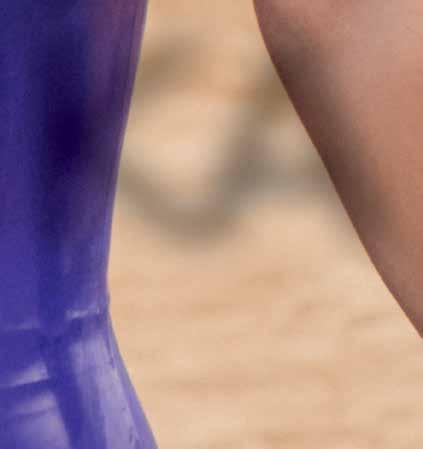




























































FEATURES
Forty Two Out Of This World
Anyone who has ever watched LaKeith Stanfield in anything will know that he is a little… different. But how different?
Forty Eight Dan’s The Man
Why everyone from Rihanna to the Kardashians loves Daniel Roseberry, the creative director of Schiaparelli.

Fifty Six Sure Shot
How Willie Christie went from Eton dropout to one of fashion’s pre-eminent photographers.
Contents OCTOBER 2023: ISSUE 145 7 Credit: Schiaparelli Haute Couture FW 23/24
AIR
REGULARS
Sixteen Radar
Eighteen Objects of Desire
Twenty Critique
Twenty Two Art & Design
Thirty Jewellery
Thirty Six Timepieces
Sixty Six Gastronomy
Seventy Travel
EDITORIAL
Editor-in-Chief & Co-owner
John Thatcher
john@hotmedia.me
ART
Art Director
Kerri Bennett
Illustration
Leona Beth
COMMERCIAL
Managing Director & Co-owner
Sixty Two Motoring

From the 356 to the 357, including the 911, Porsche has delivered some iconic digits through the years. And here’s another – the marque just turned 75.
Victoria Thatcher
PRODUCTION
Digital Media Manager
Muthu Kumar
Seventy Two What I Know Now Media City, Dubai, UAE
in part
written permission from HOT
HOT
not accept liability for any omissions or
Reproduction in whole or
without
Media is strictly prohibited.
Media does
errors in AIR
Contents OCTOBER 2023: ISSUE 145 8



































Jetex continues to set new standards and impress travel connoisseurs around the world.

This month, we are proud to unveil the unique ‘Wedding in the Sky’ concept that invites couples to celebrate love and romance at 40,000ft. Inspired by our passengers and their passion for new experiences, we designed this concept to surpass their wildest dreams.
Working closely with florists, chefs and wedding planners allowed us to consider the smallest details to ensure that the happy couple, as well as their family and friends, enjoy the celebration of a lifetime onboard some of the most lavish private jets.
Building on the success of Jetex Dubai, we look forward to presenting a brand-new experience at our flagship private terminal. We will bring together aviation history, culture, the award-winning Jetex art of hospitality, as well as superlative luxury retail concepts to surprise and delight our guests.
As always, thank you for choosing Jetex for your global private jet travels. All of us look forward to taking you higher in utmost comfort and luxury – and with complete peace of mind.
Adel Mardini Founder & Chief Executive Officer

Welcome Onboard
11 Jetex OCTOBER 2023: ISSUE 145
OCTOBER 2023
Cover : Lakeith Stanfield © Danielle Levitt/AUGUST
Contact Details: jetex.com


Meet the Pets Flying on Private Jets
A dedicated Jetex Butler is just one of the reasons your pet will love flying private with you
As flying commercial with pets becomes increasingly difficult, animal owners are turning to private aviation. The trend, which started gaining serious momentum in 2020, has sparked an influx of new companies and services designed to streamline jet-setting with furry friends.
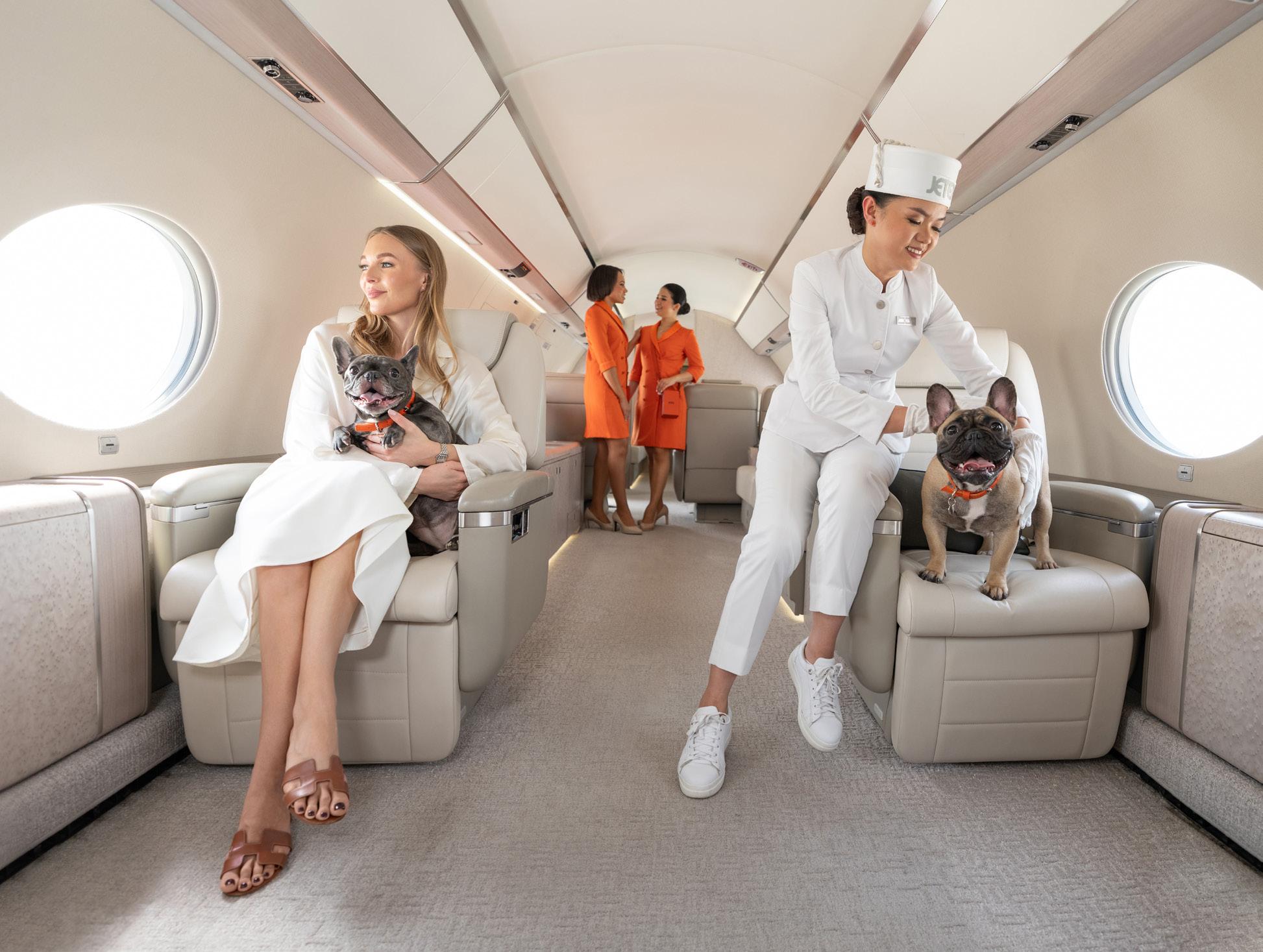
For travellers with pets, the options for long-distance hauls are limited and often stressful for both species. Commercial airlines place tight restrictions on airborne animals, especially ones that are too large for the cabin and must fly in the cargo hold or as freight. Owners pay hundreds of dollars to transport their pets by plane, plus more if their supersize dog requires a customised crate.
Pet owners seeking to transport their
pets on commercial flights must also navigate a patchwork of rules that vary by airline. Service animals, which are not considered pets, are allowed to be in the cabin and left unconfined, but other animals are subject to size restrictions that require bigger pets to travel as cargo, though some airlines won’t carry specific breeds.
Animals that can fly inside the cabin in carriers, which must fit under the seat in front of the passenger, can face seemingly arbitrary judgments about whether the carrier is big enough. Emotional support animals, which once were allowed in cabins, no longer are, according to the Federal Aviation Administration.
Many owners of larger dogs fear what might happen to their pets if
shipped as cargo, where they could face fluctuating temperatures, poor ventilation, and inappropriate handling. Meanwhile, private jet companies have stepped in, offering air travel for pets inside the plane without having them spend hours trapped in crates or carriers. Some have dedicated pet programmes.
Jetex flies pets with utmost care and in absolute comfort – in addition to cabin crew, a dedicated Jetex Butler will look after both the pets and their owners from the moment they leave their residence to the time they reach their destination.
Now pet owners can travel with complete peace of mind – their pets will enjoy the same level of love and care they are accustomed to on the ground.
Jetex OCTOBER 2023: ISSUE 145
14

“For an aircraft to fly well, it must be beautiful,” said Marcel Dassault, who was true to his word when his company’s first business jet, the Falcon 20, soared through the sky in May 1963. Now celebrating 60 years since that inaugural flight, there are more than 2000 Falcons operating from 90 countries across the globe, with the Falcon 10X set to join the fleet in 2025. Capable of flying nonstop from Los Angeles to Sydney, Hong Kong to New York, or Paris to Santiago, it’s being billed as offering a level of comfort and technology unmatched by any purpose-built business jet, including what will be the industry’s biggest cabin yet.

16 AIR Radar OCTOBER 2023: ISSUE 145

17
OBJECTS OF DESIRE
Master craftsmanship, effortless style and timeless appeal; this month’s must-haves and collectibles
OBJECTS OF DESIRE
CARTIER MINI BAGS
Designed, one suspects, with an eye very much on the Gen Z customer, though an outfit-lifting accessory nonetheless, Cartier’s collection of shrunken classics are descendants from the families of C de Cartier and Panthère de Cartier, whose designs
they adopt by way of their clasps; a metal logo inlaid with enamel for the former, the profile of a panther for the latter. With leather or chain straps, each bag can be worn around the shoulder or waist, and comes in either soft- or hard-grained leather.

1
OBJECTS OF DESIRE
Credit: © Cartier © Louise & Maria Thornfeldt
VACHERON CONSTANTIN LES CABINOTIERS ARMILLARY TOURBILLON
Commissioned by a client who wished for a single-edition timepiece to be inserted into the fascia of his also unique RollsRoyce Amethyst Droptail, Les Cabinotiers Armillary Tourbillon is driven by calibre 1990, a hand-wound in-house complication movement whose technical developments

are derived from Reference 57260, the most complicated timepiece in the world. Just as complicated was the process of setting it inside the car, a first for Vacheron, for which a removable holder was developed, allowing for the watch to be rotated through 180° for setting and winding.

OBJECTS OF DESIRE 2
CHOPARD IMPERIALE
The 23rd Grand Prix d’Horlogerie de Genève takes place in November, for which Chopard has four entries. Marrying watchmaking mastery to ancestral skills, Imperiale is undoubtedly the pick of them, an individually-numbered eight-piece limited edition of jumping-hour timepieces
that have been hand-painted. Its case is shaped from ethical 18-carat yellow gold and entirely set with diamonds, totalling over eight carats, while its dial is a true work of art, a stunning showcase of urushi, Japanese lacquer that derives from the sap of a tree.

3 OBJECTS OF DESIRE
A new bag from Bottega always delights; this one first revealed on the SS23 runway. Its relaxed, slouchy shape takes its design cues from the hobo bag, which entered the house back in 2002. Made entirely by hand, it takes an in-house artisan two full days
to fashion the bag using the brand’s signature 3D intreccio technique. Designed to be carried by hand, on the arm, or over the shoulder, it’s available in either small or large sizes and a choice of six colourways, including this ‘siren’ hue.

4 OBJECTS OF DESIRE
BOTTEGA VENETA HOP
SPEAKE MARIN
ART SERIES KOALA
As part of its charitable endeavours, each year Speake Marin produces a limited-edition Art Series timepiece (featuring colourful hand-painted dials) that’s dedicated to an endangered species. This time it’s the koala, whose population continues to decrease, with the watch launched to aid the work of
Australia’s ‘Queensland Koala Crusaders’. Limited to just nine pieces, the timepiece’s case is crafted from titanium, while the dial is micro-painted by one of two artists, making for slight alterations in the artworks to further enhance their uniqueness. It comes in two sizes, 38mm and 42mm.

5 OBJECTS OF DESIRE

6
BOUCHERON
PLUME DE PAON
As far back as the mid-19th century, Boucheron was crafting jewellery rich in extraordinary detail, elements of nature recast as hair jewellery and brooches. That was when Plume de Paon debuted, going on to become one of the maison’s signature motifs. This season sees its latest iteration, ten new

designs spearheaded by supremely light titanium peacock feathers, which, for the first time, mirror the gradation of colours on the actual feathers; diamonds, sapphires, tsavorites and tanzanites blending due to an anodization treatment applied to the titanium.

7 OBJECTS OF DESIRE
HERMÈS HAUT À COURROIES
The Haut à Courroies bag holds special significance for Hermès. The very first bag in its stable, it was designed at the turn of the century as a practical means for horseriders to carry their saddles and boots. As the horse gave way to the automobile, the Haut à Courroies
became a sophisticated travel bag, beautifully formed from the maison’s emblematic leatherwork. This new interpretation of the Haut à Courroies contains two additional, different sized exterior pockets, the smallest of which closes with a padlocked swivel clasp.
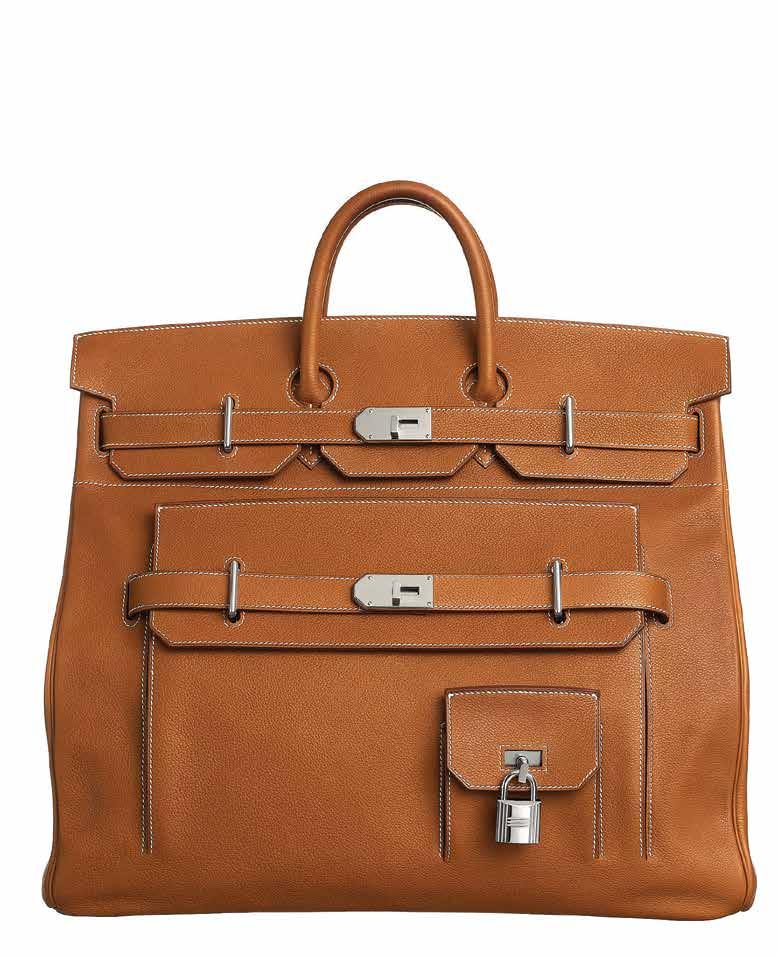
8 OBJECTS OF DESIRE
OBJECTS OF DESIRE
Killers of the Flower Moon
Dir. Martin Scorsese
Scorsese teams up with De Niro and DiCaprio for a blockbuster about the serial murders of members of the oil-wealthy Osage Nation.
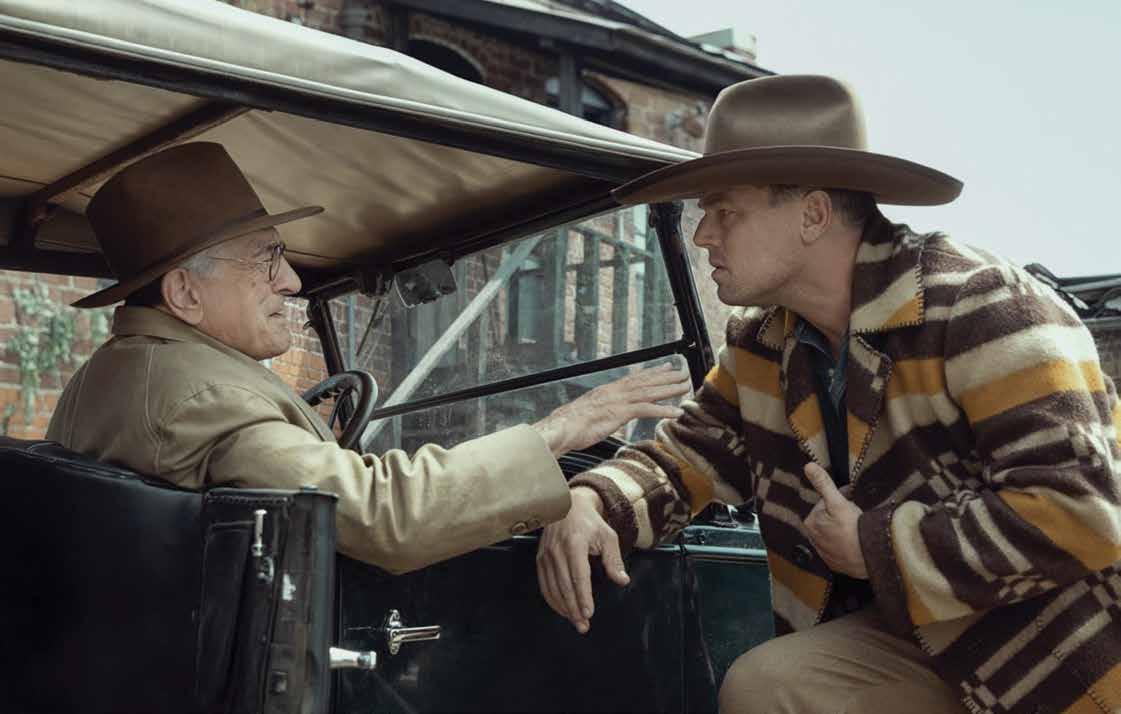
AT BEST: ‘Devastating and visually stunning American epic of greed, injustice, and cultural erasure.’ — Rene Sanchez, Cine Sin Fronteras’
AT WORST: ‘There’s a sense of the narrative going through the motions while circumventing the complex Bureau of Investigations manhunt for the perpetrators.’ — Nicholas Bell, Ioncinema.com

Fair Play
Dir. Chloe Domont
A loving relationship sours into something sinister when two employees vie for a coveted promotion at their cut-throat financial firm.

AT BEST: ‘Has the distinction of being both slick and thorny at the same time, and utterly arresting.’ — Candice Frederick, Huffington Post
AT WORST: ‘Dated and sexist rather than smart and provocative.’ — Louisa Moore, Screen Zealots
Anatomy Of A Fall
Dir. Justine Triet
A psychological drama in which a mother becomes the chief suspect following her son’s suspicious death at their home.
AT BEST: ‘Builds a taut did-she-do-it tension while also working in discomfiting questions about marital power dynamics.’ — Raphael Abraham, Financial Times
AT WORST: ‘Very much televisual in its content… seems ill-suited to be the flag bearer for theatrical cinema.’ — Ankit Jhunjhunwala, ScreenAnarchy
Cat Person
Dir. Susanna Fogel
On their first date, a college sophomore discovers that the man she met over texts is a very different character away from his phone.

AT BEST: ‘A film that carefully stresses you out as it examines the fear of modern dating for women.’ — Zach Pope, Zach Pope Reviews
AT WORST: ‘I’ve rarely seen a film scuttle itself and sink to the bottom with such determined rapidity.’ — Ty Burr, Ty Burr’s Watch List
20 AIR Critique
Film
OCTOBER 2023 : ISSUE 145
In Happiness Falls, by Angie Kim, the lives of a biracial Korean American family are upended when their beloved father and husband goes missing. “One of the smartest, most multi-layered mysteries of the year,” says The Boston Globe “Deftly crafted and truly riveting, this novel about heartache and hope, the author’s second, proves Kim is a powerful voice that’s here to stay.” The Atlanta Journal writes that, “Angie Kim’s powerhouse of a novel offers a probing exploration of the intersection of communication, speech and intelligence that not only gives voice to a silenced population but concludes with a fantastic twist.” Also full of praise for the complex plot is fellow author Jodi Picoult, who couldn’t put it down. “I read Happiness Falls in a single day. I can’t remember a book with more layers — this is a nuanced story about bias, language, ableism, racism, and family dynamics — but above all else this is

a story with so many twists and turns I was riveted through the last page.” When schoolteacher Mary Alice Roth is forced into retirement, her initial boredom is toppled by the prospect of a decade-old secret coming to light to send shockwaves through her small Texas town. That’s the premise for Bobby Finger’s The Odd Place, which Shelf Awareness rates as “Unforgettable,” adding that, “It hits the rare and satisfying double note of harrowing and delightful.” Kirkus Reviews is a fan of the author’s characterisation: “Mary Alice Roth is a jigsaw puzzle of a character, as complicated as any Henry James hero… A surprising page-turner that’s homey, funny, yet with dark corners of anger and grief,” as is the Washington Post : “Reading Finger’s playful portrait of the denizens of a small Southern town embracing and forgiving their many flaws feels like laughing with your best friend while sipping sweet tea on the back porch.”

In The Rigor Of Angles, author William Egginton examines the works of physicist Werner Heisenberg, poet Jorge Luis Borges, and philosopher Immanuel Kant, and asks whether the mysteries of our place in the world may always loom over us, not as a threat, but as a reminder of our humble humanity? “Humans are ambitious folk; we want to be able to know everything. But the world repeatedly confounds us with limitations on what can be known, and inescapable mediators between ourselves and the truth.
William Egginton draws compelling connections between Borges, Kant, and Heisenberg, three of our most audacious theorists of limitation. We are left marvelling at how much we are nevertheless able to capture of that elusive quarry called reality,” writes fellow author Sean Carroll. “The Rigor of Angels is a stark reminder of what each of us can achieve if we only remember what remarkable beings we are,” summarises another author, John Kaag.

21 Critique Books OCTOBER 2023 : ISSUE 145
Dark Romance
How an enduring love story inspired Rolls-Royce Coachbuild to craft a design masterpiece
WORDS: JOHN THATCHER

OCTOBER 2023: ISSUE 145 Art & Design AIR 22

23
Masterpiece. It’s a term that’s typically reserved to describe the most revered artworks, those widely accepted to be the greatest piece of an artist’s lifetime, the zenith of their singular skill. But what also defines a masterpiece is longevity; whether it has been, or is likely to be, hailed as such by future generations.
Though the design team at Rolls-Royce may well go on to craft other vehicles as visually arresting as La Rose Noire Droptail – the first roadster design in the marque’s modern history – there is no doubt that should the likes of Concours d’Elegance continue to be staged a century from now, La Rose Noire will be there, marvelled at anew as a masterpiece of expert craftsmanship.

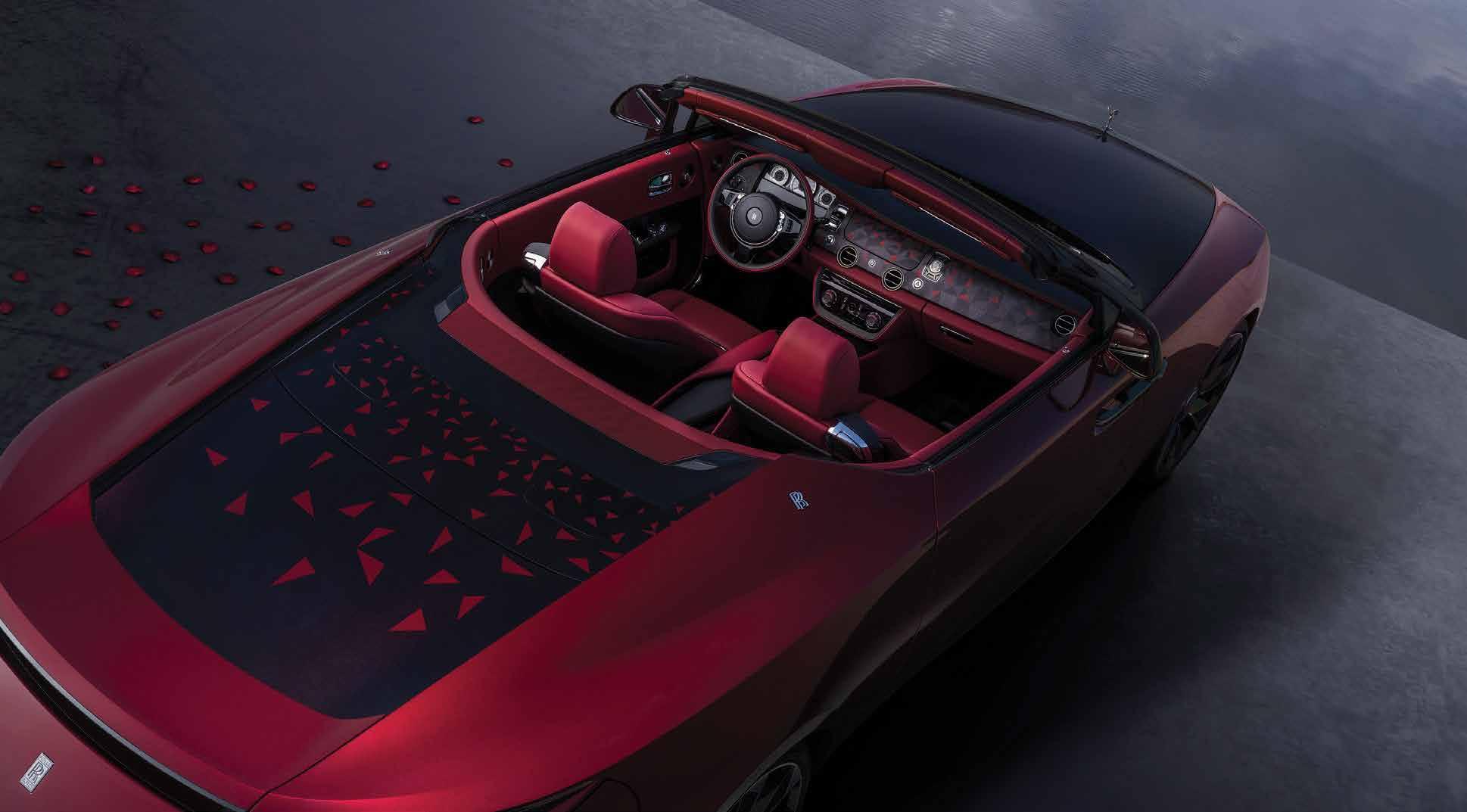
It’s the latest vehicle to be unveiled from the Coachbuild department at RollsRoyce, the almost secretive sector of the brand (the vehicles are locked away in a limited-access area of the marque’s Goodwood home, and only a select few at Rolls-Royce are made aware of any commissions) that was re-established in 2017 with the unveiling of the Rolls-

Royce Sweptail, resuscitating the once common craft of creating bespoke bodywork on a pre-assembled chassis. There then followed three Boat Tails, the first of which came to light in 2021, memorable for the sun parasol that opens up from the car’s rear as part of an al fresco dining set. Now we have Droptail, of which there will be four examples, each entirely customised and imbued with the story of its owner. In the case of La Rose Noire, it’s a love story, one characterised by the Black Baccara rose, a velvet-like flower that originates in France, from where the car’s husband and wife owners also hail. In that respect there are echoes of another, near-century-old coachbuild car from the Rolls-Royce archive, 1926’s Phantom I Brougham De Ville, otherwise labelled ‘The Phantom Of Love.’ Its owner, businessman Clarence Warren Gasque (of French descent), commissioned the car as a gift for his wife, requesting an interior that mimicked the Rococo-style décor inside the Palace of Versailles, including a painted ceiling inspired by a chair belonging to Marie Antoinette.

AIR 24
‘ So taxing was this extraordinary design element, the craftsperson responsible had to work in one-hour sessions for no more than five hours per day ’
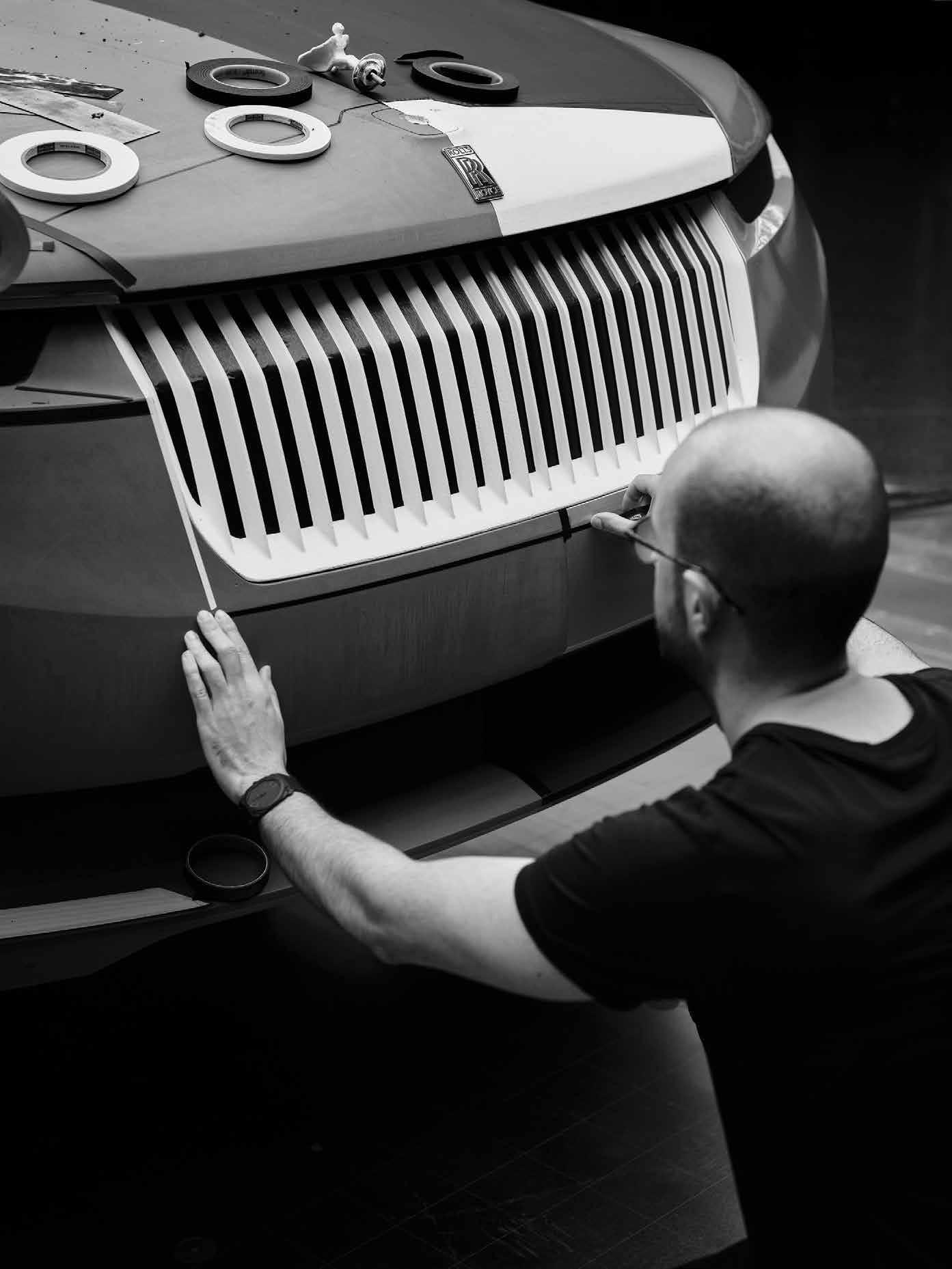
25
Extraordinarily, The Phantom Of Love also featured an elaborate French Ormolu clock, mounted between the front and rear cabins. To keep abreast of the time in La Rose Noire, there is a one-of-a-kind 43mm Royal Oak Concept Split-Seconds Chronograph GMT Large Date, commissioned by the clients along with a request that it should be both mounted in the car and removable, to be attached to a strap and worn. And just as paint helped define the design aesthetic of The Phantom Of Love, so too is it an extraordinary element of La Rose Noire.
To achieve a likeness to the remarkable hue of the Black Baccara rose, which appears red or black depending on how light falls on it, its petals decorated with a red, pearlescent shimmer, Rolls-Royce has used two shades: a red christened ‘True Love’ and a darker tone named ‘Mystery’. The latter has been applied to the car’s alloy wheels, appearing intense black at times, dark red at others. The former sees the reverse, True Love paint coating the car’s exterior coachwork and shimmering its alternate shades at the whim of sunlight. It’s a beautiful detail.
To achieve this remarkable colour variation, Rolls-Royce surface finish specialists developed a completely new paint process, perfected over 150 treatments. A fact that perfectly
illustrates the difference between coachbuild and bespoke.

So myriad are the options to bespoke your Rolls-Royce – including an estimated 44,000 paint colours – that every car that drives out of Goodwood is in effect a bespoke vehicle, no matter the model. Yet coachbuild takes things a step further. It is the difference between a made-to-measure suit and one made fully bespoke, the automotive world’s equivalent of haute couture clothing. The client is engaged in the building of the car, not just its adornments, and is able to personalise almost every aspect of it. But coachbuild is also an invitation for Rolls-Royce’s designers to stretch their imaginations beyond the marque’s existing design strategy, an exciting opportunity to play with established codes, creating a car that while identifiable as a Rolls-Royce, is also strikingly unique. Walking this design tightrope, Alex Innes, Head of Coachbuild Design, identified Droptail as an opportunity to “re-examine the fundamental tenets of Rolls-Royce design”, one of which is the iconic pantheon grille. Here, for the first time in Rolls-Royce history, it has been “significantly reshaped”, so that it curves towards the top of the radiator, creating what’s termed a ‘temple brow’ overhang. The perfect fit for the roadster design. Elsewhere, a genuine feat of artistry is La
Rose Noire’s hand-crafted parquetry, which intimately envelops the car’s two seats. An abstract expression of falling rose petals that extends from the panel behind the seats to the doors and fascia, its intricate pattern is formed using 1,603 pieces of black wood veneer triangles, sourced from a single black sycamore wood in France. This component alone took a whole two years of experimentation to perfect; just a single artist tasked with creating it, cutting and sanding each of the triangles by hand, and positioning 533 red pieces asymmetrically to represent the rose petals. So taxing was this extraordinary design element, so high the level of concentration required, the craftsperson responsible had to work in one-hour sessions for no more than five hours per day. A labour of love for a car that embodies it. There is a hand-built roof that, when fitted, transforms the appearance of the car from low-slung and sporty to stunning, sleek coupé, yet there’s no changing what the La Rose Noire Droptail really is – a design masterpiece.
AIR 26
‘ Coachbuild is the automotive world’s equivalent of haute couture clothing’






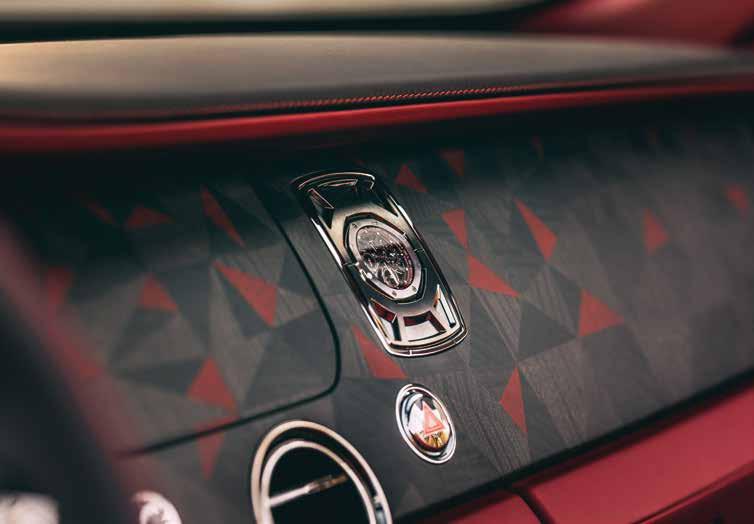
27
EXPRESS YOURSELF
The new BMW XM is for those who go against the grain — ever so gracefully. As the first original BMW M since the iconic M1, this standalone car sets a powerful legacy in motion. A groundbreaking fusion of unapologetic opulence and hybrid technology, the XM bridges these two worlds with an air of elusive self-assurance. Thanks to its formidable design, the XM is a presence that cannot be ignored. The interior lounge, with its illuminated headliner, presents the most extravagant welcome. Add unmissable proportions to the electrifying mix, and what stands before you is a triumph reserved for the select few — those whose biggest fear is blending in. Those like the entrepreneurial Anas Bukhash. The bold. The expressive. This is the XM side of you. And it’s waiting to be unleashed...
ART DIRECTOR: KERRI BENNETT
PHOTOGRAPHER: ZIGA MIHELCIC FEATURED: ANAS BUKHASH


AIR



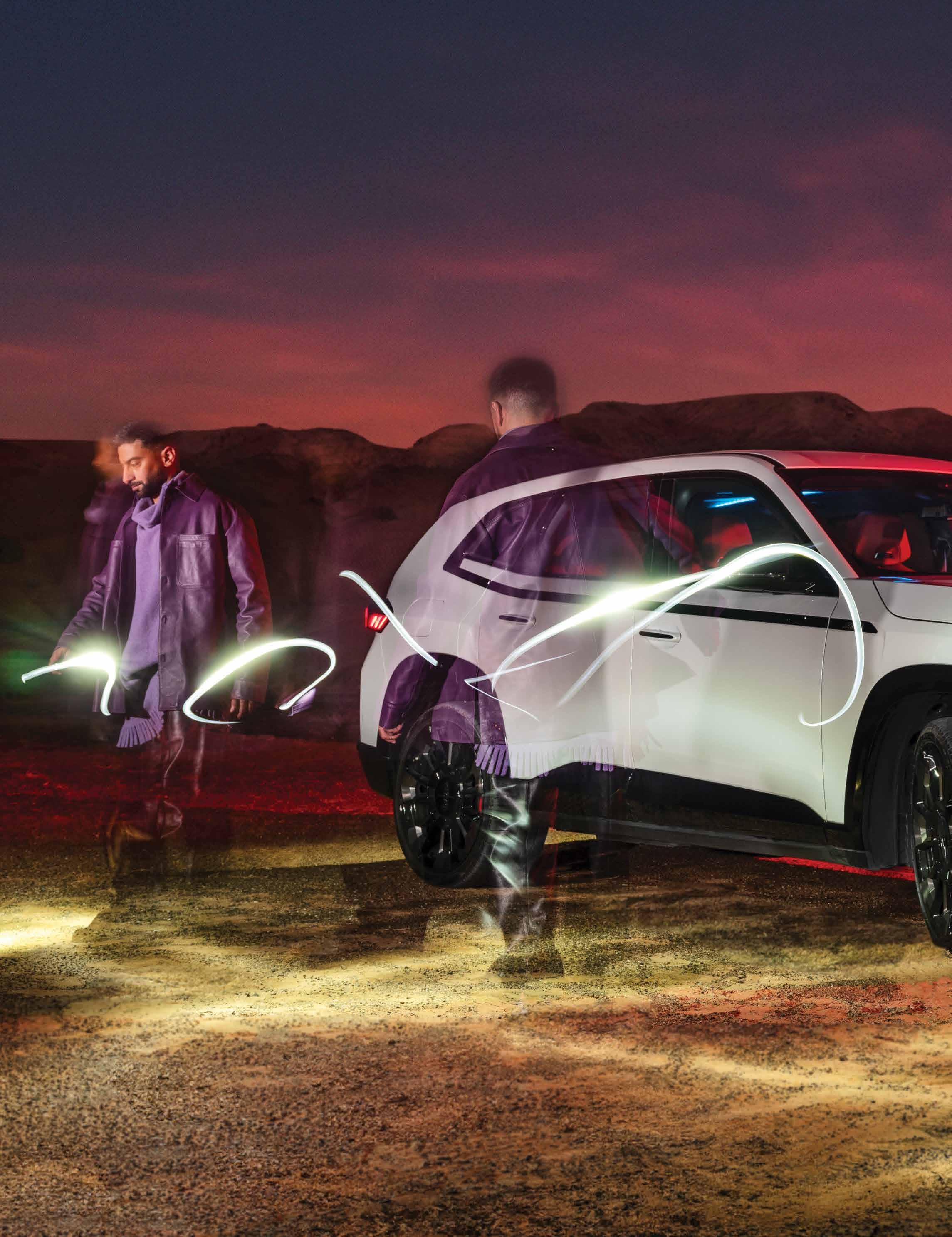
AIR


Stylist Lindsay Judge Franka Pena
Hair and Make-up Elana
Clothing
Pages 2 and 3
Jacket and trousers: Moschino Shoes: Zegna
Sunglasses and T-shirt: Model’s own
Page 4 and 5
Jacket, trousers and shoes: Ferragamo
T-shirt: Model’s own
Page 6 and 7
Jacket, jumper, trousers and shoes: Fendi
Page 8:
Shirt and trousers: Issey Miyake at matchesfashion Shoes: Fendi
Dancing In The Moonlight
Inspired by the hedonistic nightclubs of the Seventies, Messika’s latest high jewellery collection sees the brand primed to dance into its future

Jewellery OCTOBER 2023 : ISSUE 145 AIR
WORDS: JOHN THATCHER
30
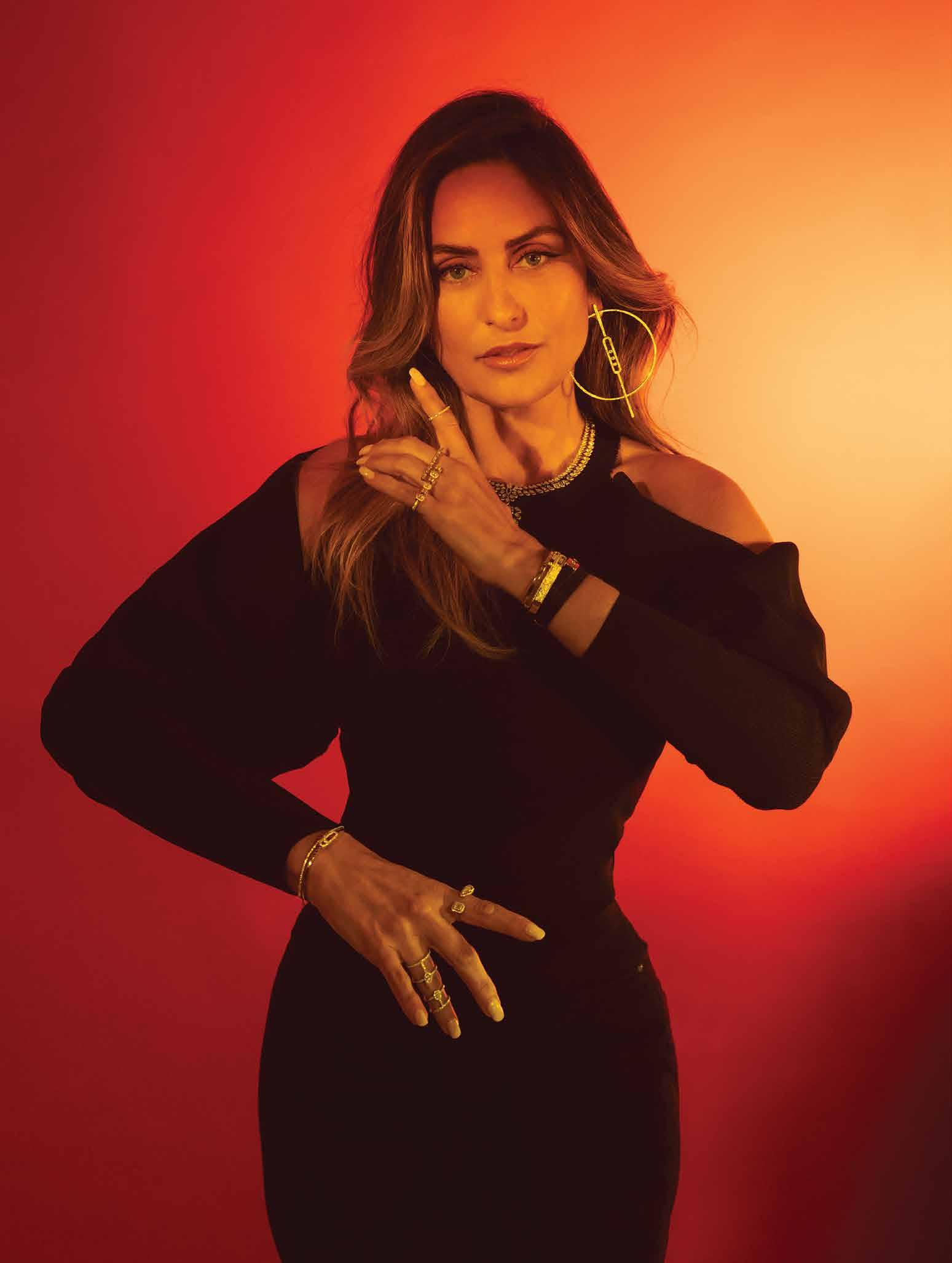
31
The summer was one to celebrate for Valérie Messika and her eponymous jewellery brand. In June, the France-born artistic director received the country’s prestigious Legion d’honneur, its highest civilian distinction, reflecting the giant strides the jewellery house has made internationally since the opening of its first flagship store on Paris’ Rue Saint-Honoré only a decade ago.
The month before saw Messika dip a toe into hospitality, the rooftop of storied Paris department store Printemps the venue for Café Messika, a summer pop-up helmed by the acclaimed Franco-Colombian chef Juan Arbelaez, which he described as “an immersion into the universe of Valérie Messika.”
That universe expanded still further in July, when Messika unveiled its tenth high jewellery suite during couture week, the twice-a-year collection that sees Valérie design around a selection of incredible stones that have become a signature of the house (it helps that her father André was a renowned diamond merchant.)
Little wonder then that Valérie was of the mind to party.
It’s that celebratory mood that informs Midnight Sun, that aforementioned tenth high jewellery collection, for which Valérie drew inspiration from the iconic nightclubs of the 1970s, specifically the hedonistic hotspots of New York and Paris, a tale of two cities keen to dance off the shackles of conformity.
“The 1970s broke all the codes of the nightlife world in New York City and Paris. This era reinvented the world of fashion, revolutionised genres, and turned the party scene upside down, thanks to the rise of clubs like Studio 54, the Mudd Club, the Palace, and Chez Régine. These two cities were animated by a joyful atmosphere at that time — an ode to self-expression,” says Valérie.
“I wanted to transmit this celebratory vibe and its message of freedom through this collection; to encourage people to be fearless in expressing their identities and to grasp the fun out of life.
“The craziest nights of the Seventies had this unwavering energy, and Midnight Sun is infused with the idea that anything goes, that you can be
whoever you want. Just let yourself go and your authentic self will shine.”
Shine you most certainly will. Split into five sets, the collection is fronted by spectacular yellow diamonds.
“These multifaceted sets are as much a play of lights and contrasts as an expression of our maison’s diamond savoir-faire,” explains Valérie.

“I wanted to make the yellow diamond shine and stand out as the queen of the night in the key pieces of this collection. By amplifying it, we succeeded in creating a chorus of exceptional sets, each more vibrant and colourful than the next. This stone encapsulates the soul of the emblematic figures of the time, like Grace Jones, Andy Warhol, and Freddie Mercury.”
Liza Minnelli and Diana Ross were muses for the Ultimate Party set, which includes an armour-like golden shield necklace [debuted in the
previous high jewellery collection] adorned with a 20.04-carat pearcut yellow diamond and a 9.07-carat cushion-cut diamond. Stunning.
For Glitter Fever, Valérie uses snow-set white diamonds for a glitter effect, onto which cushion-cut yellow diamonds (ranging from 2 to 15 carats) are used across strongshaped pieces comprising a necklace, earrings, a ring, and lip jewel.
Igniting passion, the Fiery collection sees a necklace, rings, and earrings formed to represent flames; pearshaped diamonds outlined by a halo of smaller diamonds, and outside it a flat surface of mirror-polished white gold.
The designs of the Dancing Moon collection are characterised by a radiant four-row necklace totalling 48.72 carats, at the heart of which is a resplendent 2.21-carat centre stone. Allowing for freedom of
32
AIR
‘ Our Middle East clients are setting trends instead of following them ’

33

AIR 34
Opening pages, from left to right: Midnight Sun, Joy Coeur © Sébastien
Coindre; Valérie Messika
Previous page: Midnight
Sun, Fiery © Sébastien
Coindre; Carla Bruni
wearing Midnight Sun, Fiery © Pierre-Ange
Carlotti
These pages: Midnight
Sun, Glitter Fever © Sébastien Coindre
expression, the necklace can be split into twin double-row necklaces.
It’s a ring that takes centre stage in Joy Coeur; a masterpiece composed of a 16.18-carat yellow diamond and a 7.06-carat heart-shaped diamond. The overarching theme of the collection, this joyous expression of freedom, is imbedded in the house of Messika. A relatively young brand still shy of its twentieth birthday, Messika is not bound by the history of heritage jewellery brands. It’s a position Valérie revels in. “All my creations start with a blank page. It allows me to create modern pieces and continue my mission of disrupting the codes set by the industry. For me, each new collection is a real jump into the void. I am partial to certain jewellery techniques over others; however, I always start the process without a precise brief, which helps my team and I push the limits of jewellery design further, and present something fresh and unprecedented every time.

“Our philosophy is to make the diamond come to life by making it move and dance. I always want to make wearing diamonds everyday fun and exciting.”
Diamonds, of course, have helped further define the house. “When I was little, my father used to bring home incredible diamonds. He'd let me play with them, and I loved to watch him at work. He used to let them slide through his fingers, explaining that this movement allows us to observe the luminosity reflected by the diamonds, the way in which the stone will capture and return the light.
“As I follow my father’s diamond legacy, I usually come across some stones that have inclusions, which can be considered defects. But I tend to be
drawn to these so-called imperfections and always see the beauty in them.
That’s what makes a stone unique. I call it the charm of nature.”
How does it make her feel when she sees such stones brought to life in one of her high jewellery pieces?
“It feels like a dream come true. It’s without doubt an emotional and magical experience. I get a major sense of accomplishment seeing each high jewellery piece come to life after visualising it in my head for so long. Each creation is the result of the hard work of the designers who always manage to translate my ideas into drawings, and the workshop teams who then masterfully bring them to life.”
The Middle East has proved fertile ground for Messika, not just in terms of providing clients but also ideas.
“Jewellery is a bigger part of the lives of our Middle Eastern clients than it is for clients almost anywhere else in the world,” states Valérie. “They have a culture of buying jewellery to celebrate all special occasions and like to gift it. Because they are such frequent customers, they appreciate novelty and freshness, which pushes us to diversify our offering and appeal to their ever-evolving aesthetics.
“I travel often to the region and I always go back home with a lot of inspiration. For instance, Middle Eastern women taught me the rock’n’roll style of stacking, which I still adopt today. They were the first women I saw stacking many bracelets on their wrists, and many earrings. They made me see the feminine charm behind wearing an ankle bracelet and how to make it a modern accessory. All of this played a big role in the creations I dedicated specifically to the region, a market where we have constantly witnessed clients setting trends instead of following them.”
Imbued with this same confidence, Valérie’s decision to launch Café Messika was born of a desire to “push myself further and express my identity within the art of living,” the next step of what she sees as the brand’s global vision. “My dream is to make Messika a brand that resonates with the new generation, for our maison not to be defined solely by jewellery but also by the lifestyle experiences we offer.”
Welcome to the Messika universe.
35
‘ I always start the design process without a precise brief, which helps my team and I push the limits’
Shaping The Future
With its latest model, Richard Mille proves uncompromising in its pursuit of game-changing excellence
WORDS: JOHN THATCHER

36 Timepieces OCTOBER 2023: ISSUE 145 AIR
Louis Cartier may have introduced the tonneau shape to the watch world over a century ago (the Tonneau was actually Cartier’s second ever wristwatch), but there’s no doubt that its modern-day iteration was carved by Richard Mille. Quite literally. “I arrived at the shape one night when I couldn’t sleep. I was trying to create a form that would sit perfectly on the human wrist, and that had a certain organic sensuality but also expressed my obsession with performance and technicality. I went to a hotel bathroom, unwrapped a bar of soap, and began carving it with a knife. I carried this piece of soap with me back home. Eventually it broke and I created a cardboard prototype. That was the genesis,” Mille once revealed during an interview with Revolution
Its shape ensures that a Richard Mille timepiece is instantly recognisable. “The aim is that the brand identity is always present, as was the case with the RM 5002 and the RM 62-01 with Airbus Corporate Jets, featuring a special bezel shaped like an aircraft window, or with the RM 40-01 McLaren Speedtail, whose lines, inspired by the hypercar, were blended with those of the tonneau shape,” says Salvador Arbona, Mille’s Technical Director of Movements.


Just as intrinsic to the brand’s identity is its desire to do things differently, to continually redraw technical and aesthetic boundaries (often ones it has previously set), and all the while ensuring that every single element of its watches, those we can see, and those we cannot, is afforded the same painstaking attention to detail. “Even the surfaces of components,” adds Julien Boillat, the brand’s Technical Director of Watch Exteriors. “For example, both the top and underside of the hands are always magnificent. Every element of the calibre and case is designed with its overall finish in mind, whether it is visible or not.”

The latest manifestation of this mindset is the RM 30-01 Automatic with Declutchable Rotor. A fusion of the RM 029 and RM 030, both of which are leaving the collection, the new model reveals an evolution of the design and technical
principles that underpinned both watches, harnessing the techniques, technologies and expertise that have developed since the RM 030 debuted in 2011. Or, as Arbona puts it, “We have perfected the RM 030. However, redesigning an earlier model adds extra difficulty when compared to working on an original project. We approached this project as if the watch had never existed and we asked ourselves: what’s good about it? What could be improved? Above all, we had to make sure we didn’t forget anything. The slightest adaptation can disrupt an entire timepiece.” What’s also of vital importance to Richard Mille is ease of use. Proving this point is the RM 30-01’s function selector, inspired by automotive gearboxes in a nod to Richard Mille’s love of motor racing. Integrated at 2 o’clock into the caseband, it allows the wearer to set the time, date, and wind the calibre without having to manipulate the crown into different positions to do likewise.
37
A function-selector indicator reveals which function has been activated.
Just as simple for the wearer to ascertain is the model’s power reserve level, observed via an indicator at the centre of the dial. Furthermore, you can see the declutchable rotor, the model’s primary function, at work via a small, red-tipped hand, that points somewhere between 40 and 55 hours. The rotor is automatically detached from the barrel once the power reserve reaches 55 hours, further indicated by another small hand pointing to a position marked ‘off’. When you see that the energy level has dropped to the 40-hour threshold, the rotor reengages to rewind the barrel spring and that small hand moves to ‘on.’ It’s a mechanism that allows for ultra-precise winding control.
“The RM 30-01 has all the distinguishing characteristics of a Richard Mille watch,” states Arbona. “Ergonomics, an ultra-skeletonised design, and a weight that has been reduced as far as possible.” It’s down to 96 grams, strap included,
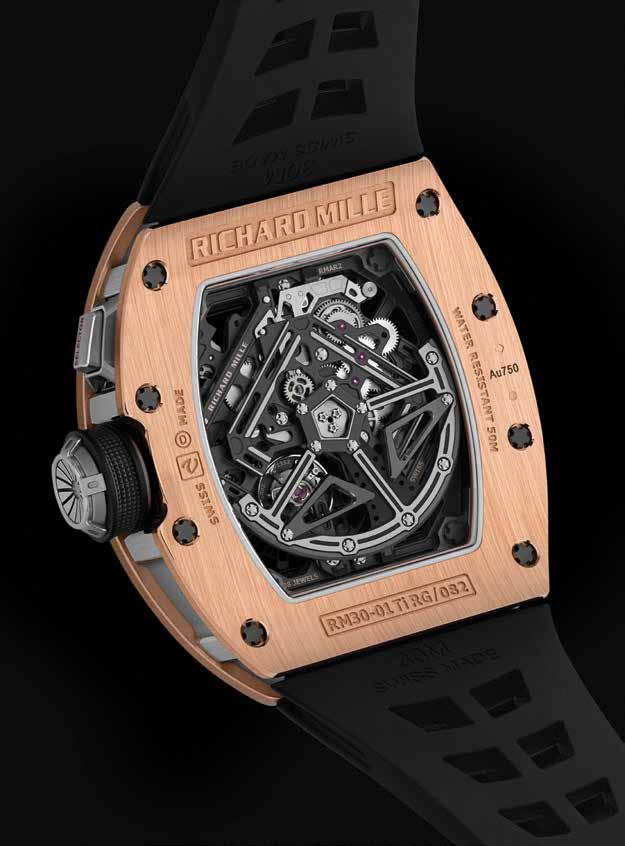
in regards to the full titanium version (the other having a red gold case with a titanium caseband). What the RM 30-01 also has in common with other Richard Mille watches is the level of testing it must endure. “Our checklist remains identical for all our watches, even if we carry out many more tests nowadays to approve a timepiece,” says Boillat.
“In concrete terms,” adds Arbona, “this ranges from ten-year ageing simulation to multiple shock tests – such as the ‘Nadal’ shock test, a demanding test performed internally on the brand’s sports watches – to say nothing of tests for water resistance and the effects of magnetism. It takes hours just to read all the lines of a product validation session. The whole process represents a year’s work. It is vital that the soundness of the technical proposals made throughout the process, and the different positions of the casing-up and flange screws, are confirmed. We move forward in stages, by partial validations. This is how the project is co-constructed.
“It’s undoubtedly a lot of work, but it’s the price we pay for peace of mind and the quality required by the brand. When a watch leaves our workshops, we know that it can face even the most demanding everyday conditions.”

In some cases, the components of its watches are perfected using the same calculations employed to design an aeroplane. Such is the territory when you scale the heights of watchmaking in a way that only Richard Mille can.
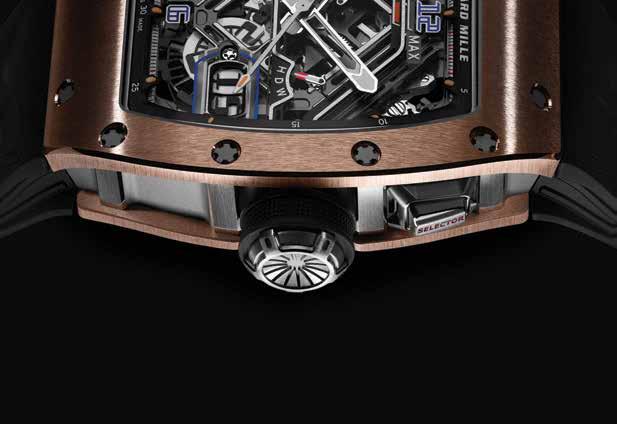

AIR 38
‘The aim is that the brand identity is always present’

39
A RARE GEM
To own a magnificent residence at Serenity Mansions in Dubai’s upscale Tilal Al Ghaf is to own more than a home. Like a piece of prized jewellery handcrafted inside the atelier of one of Place Vendome’s historic houses, it is an artistic masterpiece imbued with a story, a timeless tale to be retold through familial generations, an investment piece to be handed down and cherished time and again. An heirloom. Wearing jewellery is an artful form of self-expression; so too is your home at Serenity Mansions, a home like no other in the city that will be custom-built inside and out to reflect your distinct personality. A true gem.
ART DIRECTOR: KERRI BENNETT
PHOTOGRAPHER: ZIGA MIHELCIC
LOCATION: TILAL AL GHAF BY MAJID AL FUTTAIM

64


AIR

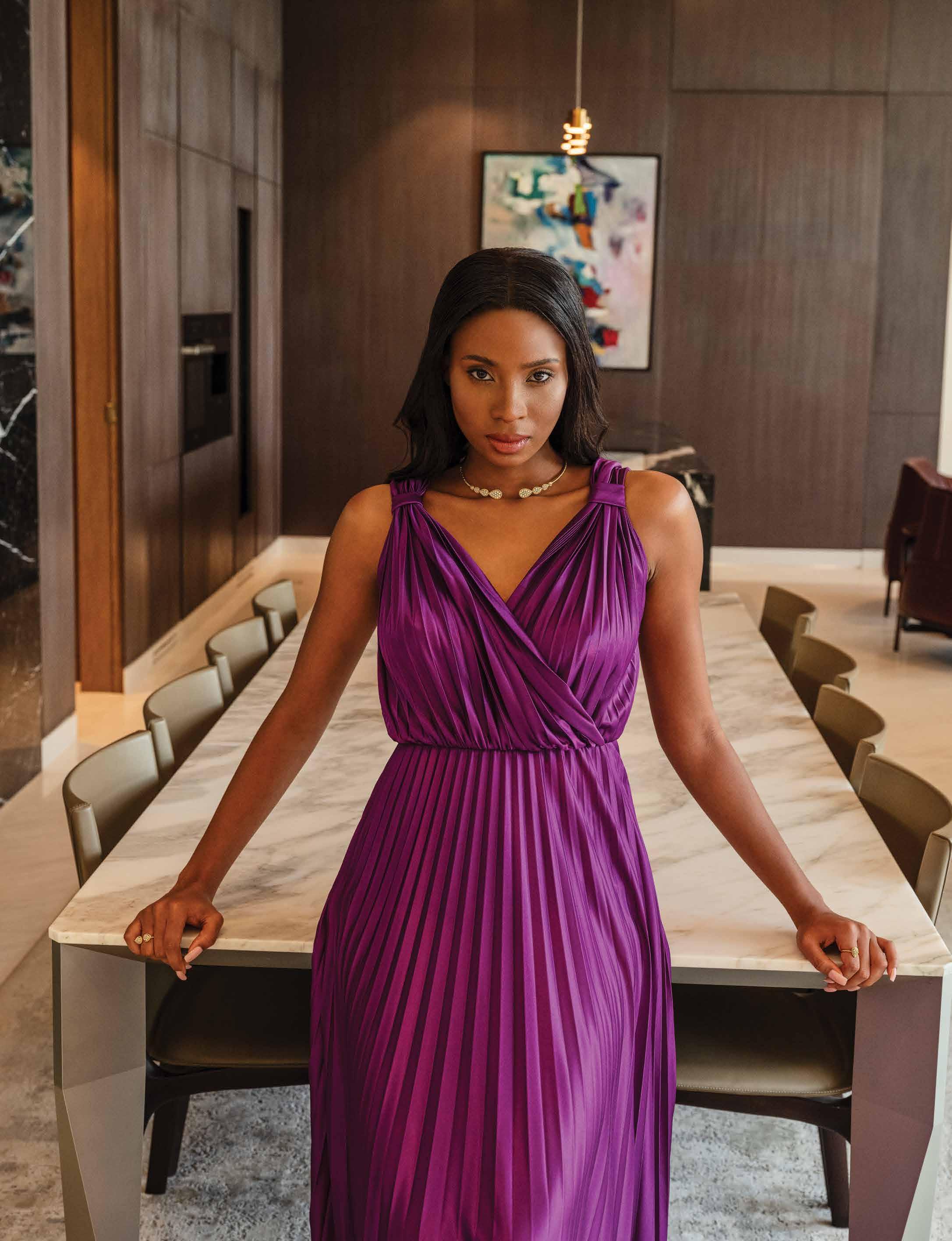
AIR 67





Stylist Lindsay Judge
Hair and Make-up Irina Model Anna Ka mlnmodel.com
Clothing Pages 1 & 2
Top and skirt: Bernadette at Matches Fashion Page 3
Dress: Taller Marmo Page 4 & 5
Dress: Max & Co Page 6
Dress: Taller Marmo
Shoes: Giaorghini Page 7 & 8
Jumpsuit: SemSem Jewellery Boucheron

42 AIR
Anyone who has ever watched LaKeith Stanfield in anything will know that he is a little… different. A little out-there. But just how different and outthere, Kevin EG Perry is about to find out…
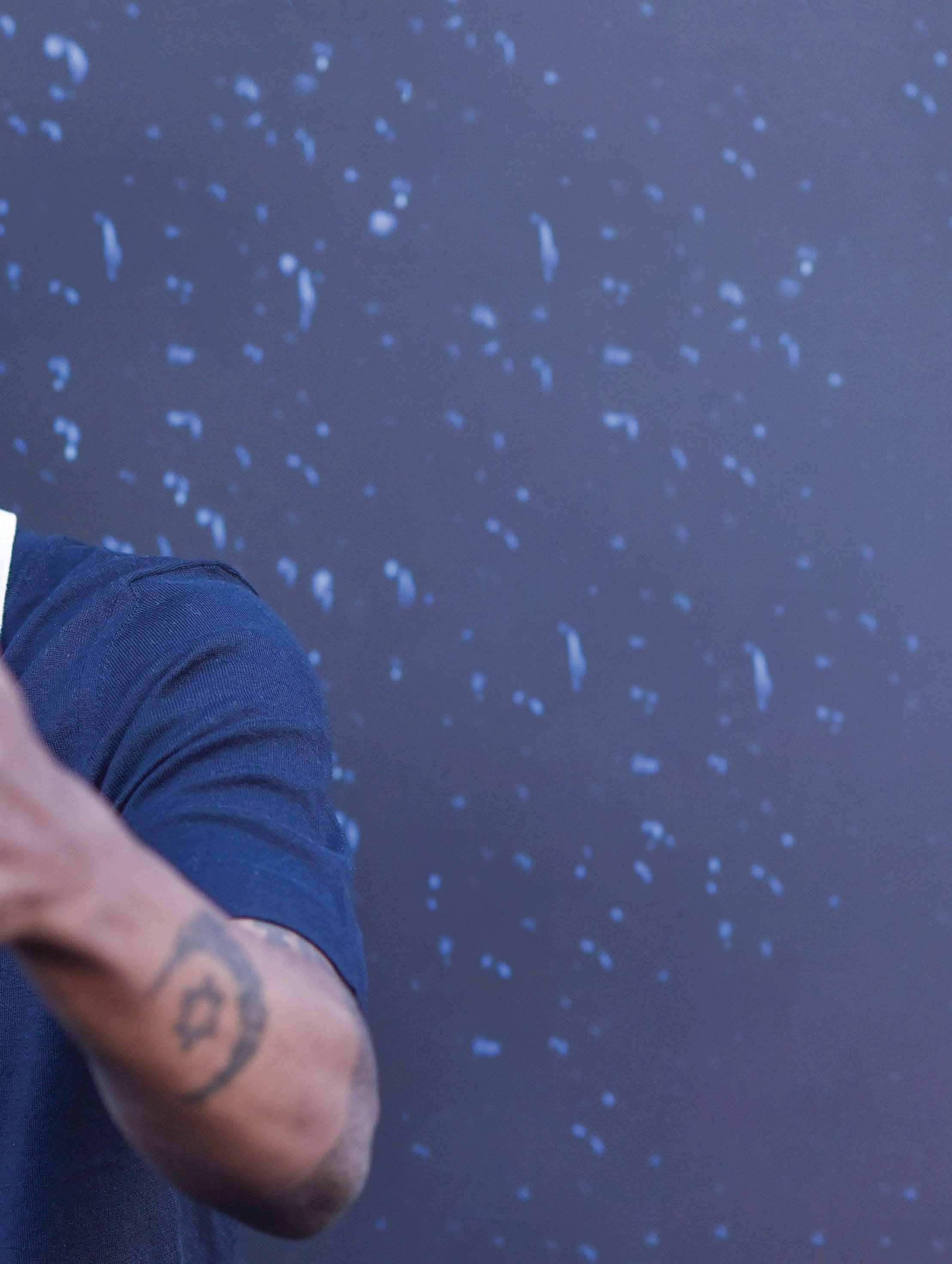
WORDS: KEVIN EG PERRY

43
Glancing around at his surroundings, it isn’t hard to see why LaKeith Stanfield might, as he puts it, “feel adrift in history.” We’re sitting on wooden chairs in a cottage on the grounds of a Pasadena hotel that dates back to the Gilded Age. Stanfield has been living here for the past few weeks while he remodels his nearby home to mimic its rustic aesthetic: exposed oak beams, heavy velvet curtains, wrought iron pokers beside the fireplace. “I like feeling like I’m in a different time,” he says. “That’s how this hotel makes me feel.” It is, he says, his hideaway from the modern world. “I’m trying to find a hole and stay there,” he smiles. “Especially these days, I’m really enjoying the things that matter, like family. Building my family and having those moments of sacredness is really important.”

Let’s bear with him for a moment, shall we? “I don’t know if it’s startmiddle-end,” he muses, his voice low and languid. “I view it as a revolution in a circle, a never-ending loop.” The 31-year-old (at least by conventional calendars) found himself pondering this concept on the set of his most recent movie, Haunted Mansion . “If you think about it like that, technically we’re ghosts,” he continues. “The question is: do you want to be a good ghost or a bad ghost? You’re in someone’s dream right now, and you’re either haunting it or making it more pleasurable. My thing is: let’s make people’s dreams a little bit more fun and cooler, make them feel good if we can.”
Over the past decade Stanfield has established himself as the most compelling, charismatic and idiosyncratic actor of his generation. His lethargic charisma is endlessly malleable, allowing him to drift through time to play an Old West outlaw in The Harder They Fall or a 1960s FBI informant in Judas and the Black Messiah (earning an Oscar nomination in the process). He is best known, though, as the otherworldly Darius, who spent four seasons of Atlanta as the trippiest, most heartfelt character on television.
When we meet, though, he’s dressed for his real-life role of family man. He wears a nondescript all-black outfit topped with a burgundy cap
embroidered with the word: ‘DAD’. Last year, Stanfield became a father for the second time, and rumours online suggest he recently married his fiancée, model Kasmere Trice. He won’t confirm this. “I can’t say!” he demurs with a grin, but he’s eager to talk about what their relationship means to him. “I’m so happy that I’ve found a person that makes me feel a love I’ve never felt, and that I didn’t know was possible,” he says softly. “It just radiates from me, and I feel like I have to share it.”
Not that love is always easy. “It takes a lot of work,” he says. “We do couples’ therapy. We do therapy individually. We’re always checking in with each other. We know this journey is a path we’re taking together, but one that takes close attention, maintenance and self-work.” The couple are building a life with his two daughters, who have different mothers. “My kids are my muses,” he says. “They’re just these balls of wonder and ignorance and excitement and knowledge and wisdom and innocence. It’s really interesting to watch them live in a world that’s tempting them to learn, but also to be mischievous. Rascality is always at the tip of their wonderment!”
His eldest, who’s six, has started to take an interest in what her dad does for a living. “My kid will see me on a billboard or something, and I always wonder how I would feel if I saw my parents up there,” he says. His answer is to try to keep their — and his — feet

on the ground. He points out the tattoo of an anchor beside his right eye. “I hope that I can instil some sense of groundedness in them,” he says. “Just cherishing the important things in life, which isn’t all those lights and those big-ass billboards. The important thing is what’s going on in your spirit. How do you feel today? So many people who you see on those billboards are not really feeling that well.”
Stanfield’s inconspicuous dadcore look today contrasts with his typical red carpet style. He considers it a “beautiful luxury” to be able to explore different shades of masculinity, and has long since given up worrying what people might think about his more flamboyant fashion choices. “I could show up in a suit, I could show up in a cowboy hat, I could show up in fishnet socks, it doesn’t matter — somebody’s gonna have something to say!” he shrugs. “Most of the people who have something to say are nekkid flipping through the channels, or online in their drawers! So what difference does it make? Everybody has an opinion, so you might as well just do whatever feels right.”
Haunted Mansion , a Disney film, represented new territory for him. “I stepped on set and was like: ‘Damn, they really got some money,’” he chuckles. “It was way different in scale to any other thing I’ve been part of.” Still, he’s not just there for the elaborate sets or the Disney-
AIR 44
sized pay-cheque. In paranormal tour guide Ben, he found a character he could relate to his own spiritual growth. “Playing Ben was cathartic for my personal journey of spirituality and soul-reaping,” he says. “We were kinda going through the same journey.”
Hang on, soul-reaping? “Going deeper into exploring your inner self to find your soul and then bringing it forth to manifest,” he elaborates, mystically. “Sometimes you’ll feel lost and you don’t know where you’re going in life. Sometimes you’ve got to really sit. For me, I’ll think out loud, which looks like I’m talking to myself.” He runs through a dialogue, playing both parts: “So then this happened”, “Why did you respond like that?”, “Well, that wasn’t really the right way…” or “Well, that was good, you stood up for yourself…” The fact that Haunted Mansion is a family blockbuster based on a theme park ride didn’t deter him from wanting to throw himself into these contemplative depths. “That’s what Ben had to do,” he says. “He had to face these challenges that taught him more about who he really was. He was able to bring out the real, truer, more honest version of himself. I felt like I did the same thing.”
The film assembles an impressive ensemble cast, including Tiffany Haddish, Owen Wilson and Rosario Dawson. Then


45
‘ I support anybody who’s standing up for getting whatever it is they need’
These pages, clockwise from above: Still from Judas and the Black Messiah (2021); still from Sorry To Bother You (2018); still from The Harder They Fall (2021)
there’s Danny DeVito, who couldn’t help but send Stanfield tumbling back through time again. “I remember watching him on VHS in the 1990s!” he says. “ Batman Returns ? He was the Penguin guy and I was like: ‘Yo, this is that guy who looks crazy as shit!’”
Haunted Mansion also reunited him with Jamie Lee Curtis, who has become something of a mentor. They first met on the set of Knives Out , where Stanfield was magnetic but underused as a police lieutenant. One day on set she caught him having a crafty cigarette and chastised him for being careless with his health as a young dad. “It was just a few little words but I knew it was coming from a real place,” he recalls. He quit smoking soon after. Later, she reached out when she heard he was contemplating sobriety. “She just really looked me in the eye and took me to task about what I wanted to do, and what I wanted to be,” he remembers. “She was someone that showed care for me, in a way that you don’t always get in this business.”
Stanfield grew up in Victorville, a quiet desert town only 90 minutes outside of LA, but got to Hollywood the hard way. “My story is very much rags to riches,” he says. “When I came to LA I was homeless for a few years.” He spent that time couch-surfing and panhandling while going on audition after audition. Time and again his hopes were dashed. “I don’t know if they still do this, but with TV shows you would sign something that has the amount you’d be making per episode right there at the audition!” he remembers, wide-eyed. “I was seeing these numbers that I’d never seen before, and I was just like: ‘F***! I could change my life! I could change my mom’s life!’ And I’d fail every single
time.” Eventually, in 2014, he walked into an audition and stopped putting so much pressure on himself. “It was The Purge: Anarchy where I finally was like: ‘I don’t care anymore,’” he recalls. “And then: Boom! It happened.”
That role lead to a handful of other small film parts. He was Snoop Dogg in Straight Outta Compton , and the guy who says ‘get out’ in Get Out . His real breakthrough came when Donald Glover spotted him dancing like nobody was watching at an industry party and invited him to be in his show Atlanta . He snatched the chance, even if he wasn’t sure he understood his character. “I remember the first day on set not really being comfortable with Darius,” he says. That soon changed. “I think what started to happen was that Darius adopted me-isms, and I adopted Darius-isms. The writers on the show were always hanging out so they would find little things about us. Darius listens to Death Grips because I do. A lot of his lines are things that I just came up with, so it is a version of me filtered through the show.” Like his attitude to time, for example: in the opening episode of season two, Darius greets someone, “I would say nice to meet you but I don’t believe in time as a concept, so… I’ll just say we always met.”
Bringing the show to an end last year was emotional. “I actually shed a tear,” says Stanfield. “I didn’t expect to, but after seven years… I forged so many friendships with people like Donald and Brian [Tyree Henry]. He’s really my friend, like how Darius and Alfred are friends. It’s special.” The rest of the core cast, which also included Zazie Beetz, have all found their way into the Marvel Universe. Would he join them? “Yeah, I’ve seen a couple of Marvel scripts,”
he says with a sly grin. “I’ve just been… a little selective. Honestly, when they call me with a villain I’ll be more excited! If I’m gonna be in a superhero thing, I’d rather be the bad guy.”
The success of Atlanta helped Stanfield graduate to leading man status in films like Sorry to Bother You , Boots Riley’s genius gonzo blend of pro-union activism and, as Stanfield recalls with a laugh, “horse people.”
Riley’s outspoken political stance has informed Stanfield’s own politics and he supports the ongoing Hollywood writers’ strike (which has now encompassed actors, too). “I think it’s necessary that people get what they’re owed, and that’s what the writers are saying,” he says. “I support anybody who’s standing up for getting whatever it is they need, unionising and saying that we deserve more. That’s something any honest worker should support.”
He’ll next be on screen in Bibleera epic The Book of Clarence . Set in Jerusalem in 29AD, Stanfield plays down-on-his luck Clarence, who attempts to capitalise on the rise of Jesus’ celebrity for his personal gain.

“It feels profoundly powerful to me, this movie,” says Stanfield, who grew up in a deeply religious family. “As a teenager I was quite rebellious, so I dropped all my belief in any kind of spirituality. I took the atheist route. As I grew, I started to realise that there is some divinity to this whole thing.
I think we’re all talking about the same thing. There are some profound universal truths told through this story, and it’s still fun! It’s in 29AD, with all these people in 29AD attire, which is akin to Star Wars . Well, I guess Stars Wars is akin to it.”
LaKeith Stanfield is slipping off through time again.
AIR
46 Credit: © ES Magazine/The Interview People
‘If I’m gonna be in a superhero thing, I’d rather be the bad guy ’


47

48 AIR
DAN’S THE MAN
Everyone from Rihanna to Joan Collins to the Kardashians loves Daniel Roseberry, the creative director of the famed Parisian fashion house, Schiaparelli

WORDS: CAROLINE LEAPER

49
At the Maison Schiaparelli even the canapés are gilded. They are blackberries that have been sprayed gold and then speared on to pure white feathers: couture kebabs. Earlier this year, though, it was the creative director of the famed Parisian fashion house who found himself somewhat skewered, by internet commentators.
During the January couture shows in Paris, Daniel Roseberry sent supermodels Naomi Campbell, Shalom Harlow and Irina Shayk down the runway in dresses and coats embellished with the life-sized heads of wild animals. Kylie Jenner posed on his front row for the scrum of photographers, wearing a similar lion-adorned dress. Animal rights campaigners immediately branded the designs ‘grim’, unaware that the snow leopard, lion and she-wolf heads had been created by vegan artists in resin, silk faux fur and embroidery. Nor did they care that Roseberry’s inspiration for the collection had been the medieval Italian poet Dante Alighieri’s Divine Comedy. It was the talking point of the season. But perhaps that was the intention?



“I knew there would be a knee-jerk reaction because they looked so lifelike,” Roseberry says now, after the storm. “But the narrative that took hold for a few days was not predicted by me or anyone else. It’s such a fascinating episode, because if the animals were not as well executed, or if they were sparkly, it wouldn’t have been an issue. It was the fact that they were photorealistic.” Insiders say that the garments are now unavailable for purchase and have been archived, permanently. Roseberry himself, impeccably mannered and sporting an immaculate salt-and pepper beard, is very much on view. “Truly I was not personally negatively affected by the backlash,” he says. “I was so proud of what we did, I still am. They are an instant chapter of classic Schiaparelli legend, like the lobster dress. Hopefully one day people will refer to the snow leopard dress.”
The lobster dress he speaks of is one of Elsa Schiaparelli’s most famous creations. In 1937 the Roman designer commissioned Salvador Dalí to create a piece for her. He hand-painted a giant lobster, symbolic of sexuality (to him), on to a silk chiffon gown; he was stopped only by Schiaparelli herself
from adding mayonnaise to the image. Once seen, never forgotten; Wallis Simpson immediately needed to wear it. Schiaparelli’s life was filled with eccentricities: she attended a party in the late 1940s dressed as a radish, and adorned coats with buttons spanning padlocks and keys, surrealist eyes and lips, vegetables, ships and insects. Her signature colour was, of course, shocking pink – a shade she claimed to have invented. As well as harnessing Dalí’s talents, she worked with Jean Cocteau, Cecil Beaton and Man Ray. And from her commanding position in her label’s headquarters, next to the Ritz Paris in Place Vendôme, she revelled in a fiery rivalry with Coco Chanel. The business is still run from here, despite having gone bankrupt in 1954, a victim of postwar austerity and Schiaparelli’s refusal to bend to the prevailing New Look aesthetic. It was relaunched only in 2014, by Diego Della Valle, the billionaire chairman of Tod’s Group. Roseberry, 37, a native of Texas, has been at the helm since 2019 with a mission to shake up the stuffy world of couture with a little Schiaparelli madness. We meet in Roseberry’s large, sunny corner office, which is almost empty except for two brown leather chairs and a selection of sculptures from Elsa Schiaparelli’s private archive. A 1930s shell-topped plaster
50
AIR
‘ I think that fashion is a multisensory experience’
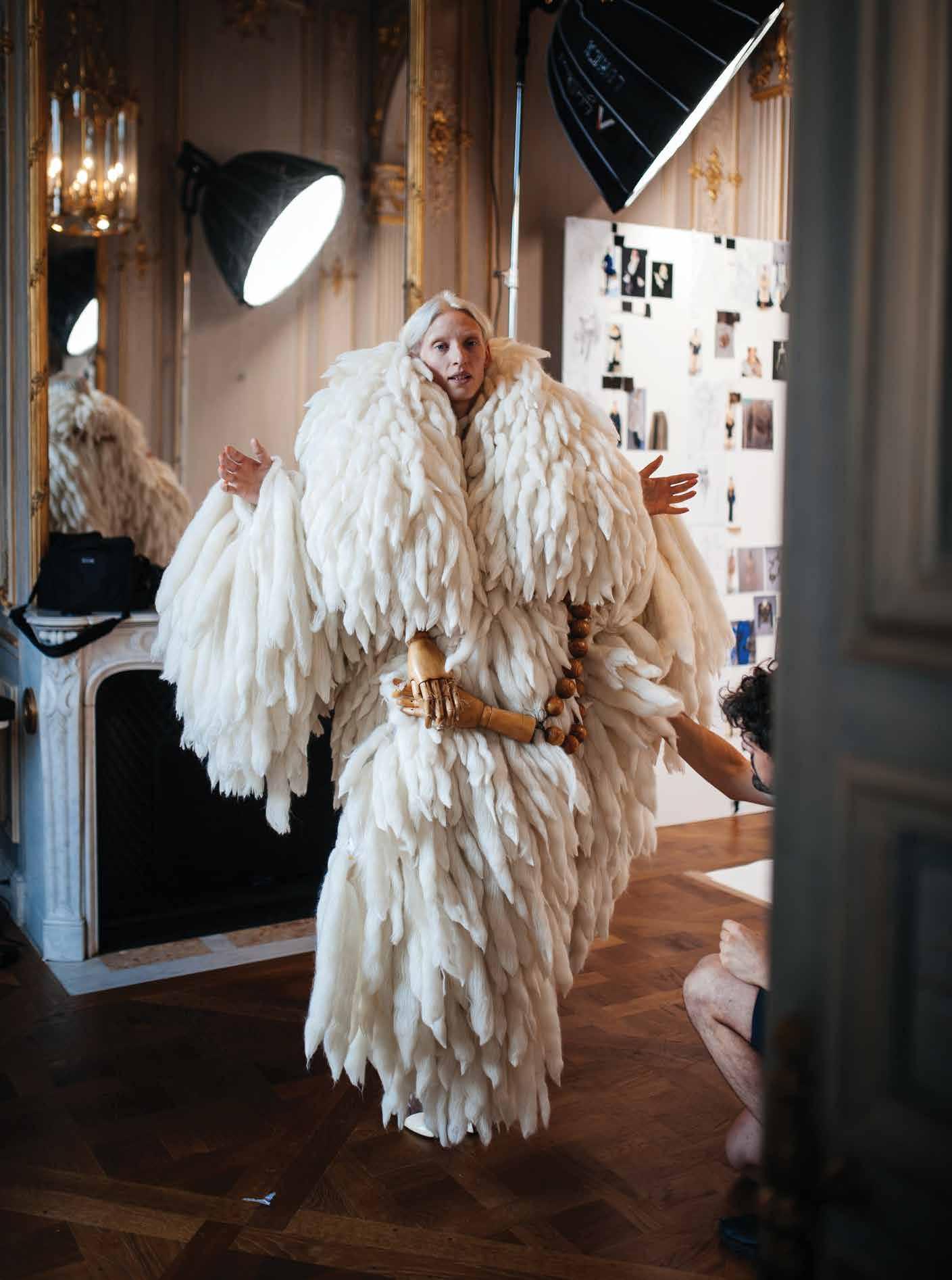
51

52 AIR
column by Alberto Giacometti ‘looks perfect today’, Roseberry notes.

His own aesthetic, despite spending 11 years designing for the avant-garde New York label Thom Browne, is both maximalist and surreal. In his world of kooky luxury, almost-lifesize gold faces embellish handbags, spinal embroideries run down the backs of jackets, and knits are trompe l’oeil. Before arriving at Schiaparelli, Roseberry had never worked on couture, which, he says, gives him a curiosity and energy that he is using to his advantage. “When I started here, I found couture quite sleepy,” he says. “It was all predictable and expected.”
Roseberry’s reinvention of Schiaparelli (he likes to shorten it to ‘Skap’) taps into the codes set by the brand’s founder – wit, charm and surrealism – and makes them relevant for a social media age. Every outfit he has designed feels offbeat and provocative, a conversation starter whether worn at a dinner party or a film premiere. What would Elsa Schiaparelli and Dalí have made of TikTok? Embraced it, no doubt: that lobster dress would have gone viral.
“I want you to know immediately
that it’s Schiap,” Roseberry says of his design signatures. “It can never look boring. But the challenge isn’t to not be boring – it is to always make it look controlled and chic. A lot of designers can do crazy volumes or try to shut down the red carpet [with an outré design], but if it doesn’t have rigour, it starts looking like somebody else’s work.”
For the past four years, Roseberry has explored the exquisite techniques at his disposal thanks to the expertise of the petites mains who create what he dreams up. A couture dress, which is made to measure for each customer and can cost hundreds of thousands of pounds, is still the pinnacle of fashion, but Roseberry is exploiting those ancient crafts to create something entirely new. His spring/summer 2023 collection featured marquetry bodices and sculpted brass bras. His most recent show, in July, pushed things further.
“I want to take full advantage of this opportunity to work with masters in Paris,” he says. “Design teams behind ready-to-wear shows are usually young, but for couture, it’s people of a certain



53
‘ The other houses feel so overexposed. The Schiaparelli customer wants something that’s less ubiquitous’
All pages: behind the scenes and fittings, Schiaparelli Haute Couture FW
23/24
age, a generation with expertise. It’s an honour to work with those people.”
Roseberry is a self-confessed entertainer, and fashion is his stage. He has referred to fans watching his shows on Instagram as being in “the cheap seats,” which might sound harsh but he means it affectionately. Roseberry is one of the least aloof luxury designers, readily acknowledging that he needs a mass audience. He wants to entertain everyone regardless of whether they can afford an €18,000 gold tweed coat. Tellingly, Michael Kors, that most commercially minded and democratic of designers, has been his inspiration since he watched a documentary about the New York fashion mogul as a teenager.

“I think that fashion is a multisensory experience,” he explains now. “Fashion shows appealed to me because they are a combination of theatre and music.” And then he adds that “the captive audience part also felt a little bit like church to me, so that felt familiar.” Familiar because Roseberry’s father, David, is a preacher

in what he calls a “megachurch” in Plano, north of Dallas. His artist mother, Fran, is also a born-again Christian. The entire Roseberry clan, including four siblings and an array of cousins, attend his shows. Dallas, with its oil money, has long been a fashion hub; astute businesswoman Coco Chanel visited in 1957 to promote her label. “I grew up on the other side of the tracks,” explains Roseberry. “But I went to school in a really fancy part of Dallas. There I saw a lot of women who were very elegant, very old money.” Watching his mother put on her jewellery for church, though, was more formative: “My mom has more grace in her pinky finger than some of those [rich Dallas women]. She was for me a model of elegance that I always dream of.”
Roseberry moved to New York to study at the Fashion Institute of Technology and was hired by Thom Browne in 2008. By 2014 he was head of design. “Thom Browne was an amazing training,” he reflects. “No one does tailoring like Thom and I’ve brought a lot of that to

Schiaparelli. But I think the biggest thing I learnt from him was to be a decent person. Thom has been able to maintain that decency throughout a very long and distinguished career with all the trials and tribulations. Because this can be such a hard job.”
Coming from behind the scenes at a New York house, Roseberry was as surprised as anyone when he was offered the golden key to Schiaparelli. “I knew zero about Elsa Schiaparelli before I got the job,” he admits; he thinks this is part of the reason Della Valle chose him: “I think they needed someone who was respectful, but not fan-boying out about Elsa. They have enough fans working here. There are enough people who are so in love with her, I don’t need to be. The admiration I have, or the fetish I have for her, is just about the work.”
If Elsa Schiaparelli courted the artists of her day, then Roseberry loves nothing more than to collaborate with Lady Gaga, Adele, Naomi Campbell or Joan Collins. So far this year, the roster of women he has dressed for awards ceremonies has
54 AIR
‘ The challenge isn’t to not be boring, it is to always make it look controlled and chic’
been more than stellar. “The red carpet has been like another runway for me,” he says. “It’s storytelling, amplified by the helping hand of the person who’s wearing it and people’s inherent love – or not – for that celebrity.

“Dressing someone for the red carpet is performance art,” he says. “I love a brief and a clear character to work with. Designing something for Rihanna is a completely different exercise to designing something for Michelle Yeoh. I love dressing celebrities – I know some designers hate doing it and won’t touch it.”
He’s also building a loyal, if more discreet, clientele in the big markets of the US, the Middle East and China. “The thread that connects all of these women is that they want something that is the antidote to things that feel very familiar,” he muses. “The other houses feel so overexposed. The Schiaparelli customer wants something that’s less ubiquitous” – and therefore more memorable.
Roseberry presented his debut ready-to-wear collection for the house in March, during Paris Fashion Week. From the tailored black jackets designed to mimic Schiaparelli’s 1937 ‘Shocking’ perfume bottles, to the bags with melted-gold keyholes, every item in his debut collection felt offbeat and therefore interesting.
“With every part of the collection I want it to feel a little left of centre,” he says. “The clients want something they won’t see on everyone else. Sometimes the silhouettes feel familiar, but there’s always a decadence to them and a twist. The world doesn’t need another it bag.”
Roseberry’s Parisian set-up is charmed too: he lives in the 7th arrondissement, with what he has called a “reassuring” view of the neo-Gothic Basilica of Saint Clotilde. His own plot twist? Deep down he hates the city. “Do you want to end the interview on a high note, or on this question?” he says, grinning. “I’ll try to squeak out a positive answer. I have nothing to complain about. I mean, it’s the most special place to make clothes in the world. But as a city to live in… you have to bend to Paris, Paris doesn’t bend for anyone. It’s a huge challenge to live in a city you don’t love.”
Regardless, Roseberry is not deterred. On the contrary, he’s digging in harder. After all, as he says, “Paris is just the setting. I’m giving Schiaparelli my all.”


55 Credit: © Caroline Leaper/ Telegraph Media Group Limited 2023

56 AIR
Willie Christie gave up photography in the early 1980s, putting an end to an influential but short-lived career in fashion magazines. He had other interests to pursue, with a lifelong love of film steering him towards TV commercials, and his featurelength writing and directorial debut. It would be another 25 years or so before he revisited his photographic work, with the passing of time giving him a new perspective, and the realisation that maybe he had given up too soon.
“At one point, I nearly binned the lot,” Christie laughs. “I had all of these negatives, and in my mind I’d been there, done that, and it never occurred to me that anyone else might want to see them again. But my brother-inlaw stopped me, gave me a scanner, and persuaded me to catalogue them all. Looking through, I felt encouraged to try a few exhibitions, then limited-edition prints, and now I have my first book coming out.”
Published by ACC Art Books, Willie Christie: A Very Distinctive Style, Then & Now, is a journey back in time,

57
How Willie Christie went from Eton dropout to one of fashion’s pre-eminent photographers
WORDS: CHRIS ANDERSON
with Christie’s work, predominantly for British Vogue , recalling the bold fashion of the 1970s onwards. There are also sections on his work with celebrities, and later his commercial photography, shooting for popular brands. “I came into it all through fashion, which initially I had no interest in,” Christie admits. “But I actually really liked it, as you have all of these people working with you, from the model to the make-up artist, and you’re one unit – everyone is striving for the same goal.”
Born into a British aristocratic family in London, Christie fell into photography as a teenager, and in the late 1960s found work assisting Clive Arrowsmith, one of the top fashion photographers at the time. Eventually, he felt confident enough to set out on his own.
“I shot my first Vogue cover at age 24,” Christie recalls. “It was a fascinating

time to be a photographer. There was myself, David Bailey, other big names, and you would drop into the Vogue offices, head to the photo studio, see who was working, and what lights they were using. We fed off each other. As far as we were concerned, we were making art. You really considered the background, the lighting, the positioning. Quite often, an image would run just for being beautiful, regardless of whether you could see the clothes or not.”
Christie cites the cover image of his book as a prime example – originally used as one of his Vogue covers, featuring a mouth biting into a block of green jelly, chosen at the time in recognition of the issue’s colour theme. Other shoots would even involve some of the big names in modelling back then. “I photographed Grace Jones before she broke into music, and she was a lot of fun, drinking bubbly in
Opening page: advert for Sarah Medway
Shoes for Vogue
This page, from top to bottom: David Bowie, Catherine Deneuve, and Susan Sarandon; Carrie Nygren for Vogue
Opposite page: Carrie Nygren for Vogue

AIR 58
‘ Quite often, an image would run just for being beautiful, regardless of whether you could see the clothes or not’

59
the studio while we were shooting,” Christie recalls. “And Jerry Hall, I was one of the first in the UK to shoot her, which I did at Pinewood Studios on the set of the Bond movie, The Spy Who Loved Me . Just incredible. So tall, and all of that hair at the time was pretty unusual. She knew how to use it too.”
Occasionally, Christie’s photography would take him away from the fashion world – in 1973, he shot the sleeve of the Robert Fripp and Brian Eno album (No Pussyfooting), setting up a mirrored room, and winning a Music Week magazine award for the result. Eno was, of course, a co-founder of Roxy Music with Bryan Ferry. “And on my Wikipedia page, you’ll see it says I played bass in 1973 with Roxy Music on Top of the Pops ,” adds Christie. “I was friends with David Enthoven at EG Records, and I’d become his unofficial photographer. He’d signed Roxy Music, and when I dropped into his office one day, he shouted, ‘You’ll do!’ Roxy Music were due to go on the TV that night, and nobody could find the bass player. I had

to fill in, and even signed autographs afterwards in the bass player’s name.”
Christie also crossed paths with David Bowie, on the set of The Hunger in 1983 (“Some in-production images for a magazine, a lovely guy,” he adds), and Hollywood greats such as Cary Grant, Douglas Fairbanks Jr, and AnnMargret. “I used to play frisbee as a kid, and Fairbanks Jr had a house nearby in London,” says Christie. “Occasionally, we had to knock on the door, and ask his butler if we could have our frisbee back. But he was very suave. Cary Grant was too. He was doing an interview, and I was taking the pics. I’d only got two rolls off and he said, ‘I think you’ve got enough now.’ I just sat down and listened to all of his Hollywood stories, which were fascinating.”
In 1976, Christie’s older sister married Roger Waters of Pink Floyd, which led to a working relationship with the group, directing a four-song video and designing the sleeve for 1983 album The Final Cut. He also has a fondness for the Rolling Stones, the subject of
one of his first ever solo shoots at Apple Studios in 1969. “Mick Taylor had just joined the group, after Brian Jones, and they were oblivious to me, in their own world,” Christie recalls. “Mick Jagger was dancing, doing all the moves, not for the audience, just for himself. And Keith Richards? I remember he was two hours late, but when he arrived, coming down this staircase, surrounded by heavies, it was like the Gods descending.”
Clearly, these were memorable times, with Christie later moving into commercials and film work, writing and directing 1998 movie The Whisper, which even made it onto the BAFTA shortlist. But much as he found himself becoming disenfranchised with photography, the same later happened with his other work, until he came full circle, rediscovering the gems in his old image archive. It’s good to welcome him back.
Willie Christie: A Very Distinctive Style, Then & Now is published by ACC Art Books, accartbooks.com
60
AIR


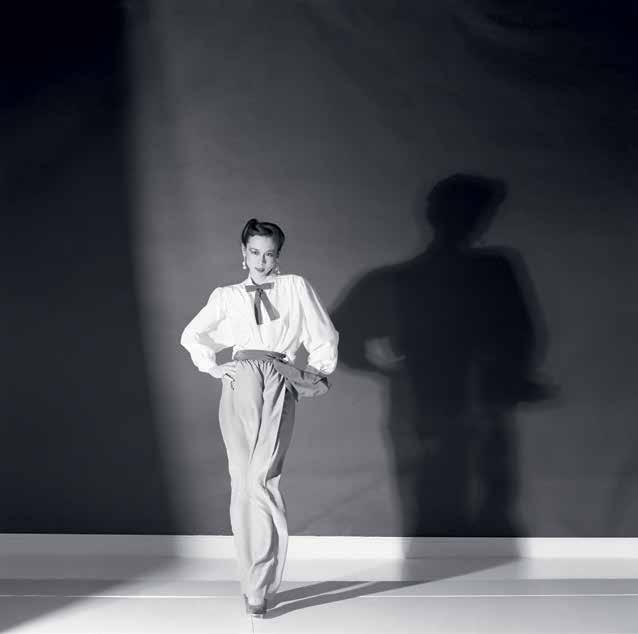

61
Opposite page: Jerry Hall for Vogue This page, clockwise from above: Tina Chow; Ann Margaret; The Rolling Stones; cover of Willie Christie: A Very Distinctive Style, Then & Now, by ACC Art Books. All images © Willie Christie
Time Machines
As Porsche celebrates its 75th anniversary, we look back on its most memorable models
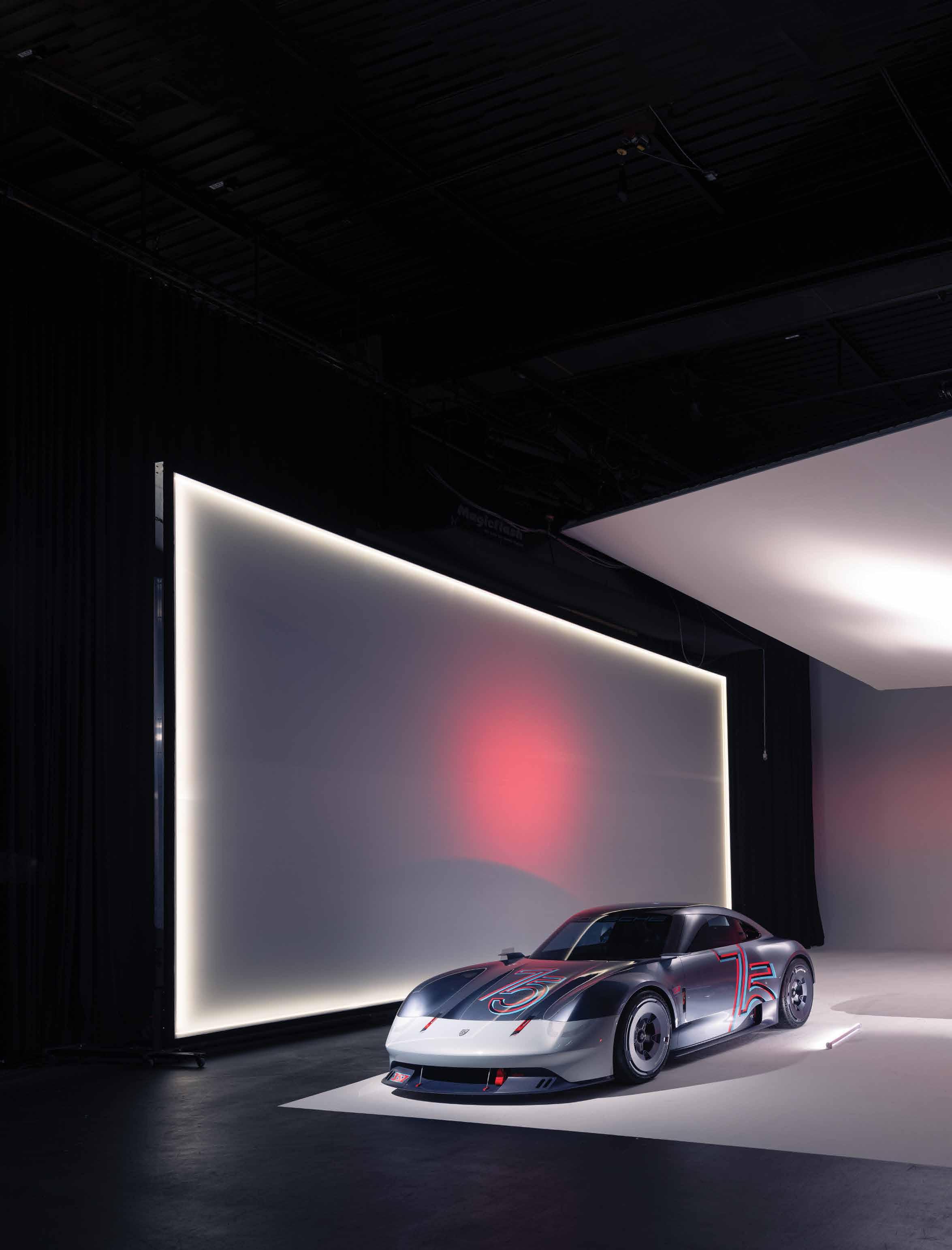 WORDS: CHRIS ANDERSON
WORDS: CHRIS ANDERSON
Motoring OCTOBER 2023: ISSUE 145
62 AIR

63
Anyone with an encyclopaedic knowledge of Porsche may dispute the claim that it’s a mere 75 years old. Like the stereotype of the middle-aged man buying a Porsche car to appear younger, might the marque be trying to lie about its own age, or is it just an excuse for a celebration? After all, it was 1931 when Ferdinand Porsche co-founded his automotive company with Adolf Rosenberger in Stuttgart, Germany, with the Volkswagen Beetle one of its first creations, a commission from the government.
But the anniversary specifically refers to June 8, 1948 – the date that Porsche’s first car bearing its own brand name, the 356 No 1 Roadster, received its general operating permit, allowing it to be sold to the public. At this point, Ferdinand Porsche’s son, Ferry Porsche, had taken over the running of the company, and this lightweight, rear-engine, two-door sports car had been his idea. He is quoted as saying, “I looked around and could not find quite the car I dreamed of, so I decided to build it myself.”
Fast forward 75 years, and so many more ‘dream’ cars have rolled off the Porsche production line, with the current line-up including the 718, 911, Panamera, Macan, Cayenne and Taycan. This is a legacy worth celebrating, with a new book from publishers teNeues, Porsche – A Passion For Power: Iconic Sports Cars Since 1948, written by Porsche expert Tobias Aichele, combining archive imagery and studio shots by legendary automotive photographer René Staud. Each model, from the 356 to the Taycan, is beautifully illustrated, with its history
and specifications outlined in-depth. For example, it reveals that much of the 356’s parts initially came from the Volkswagen Beetle, but by the early 1950s Porsche had graduated to its own, producing hardtop coupé and convertible options, as well as a roadsters. The same decade also saw Porsche venture into motorsport, initially with the 550, based on the 356, keeping the mid-engine design, and winning the first race it entered, the Nurburgring Eifel Race, in May 1953. Porsche later designed the single-seater 804 for Formula 1, competing in the 1962 season.
These cars set the tone for production in the decades that followed. With its successor for the 356, the 911, built from 1964 until 1989, the brand achieved iconic status. This model was designed by Ferdinand Alexander Porsche, son of Ferry Porsche, grandson of the original founder. In 1972, a new executive board saw the removal of most family members from management, so Ferdinand left and founded his own design company, Porsche Design, still going strong today. Flipping through the book, it becomes apparent just how many Porsches from history must have been wheeled into Staud’s studio in the German town of Leonberg for photography. Like Porsche, Staud was born in Stuttgart, and is himself a huge fan of the marque, having owned around 40 examples, 25 of them being 911s. Today, his collection consists of 11 cars, with six being historic and five new. However you look at it, there is probably no better photographer who could contribute to a book on Porsche. Among the models shot is the 917 Ping Pang Sau, a one-off 917/20 model with
a wide body, extreme curves, a low, flat nose, and a pink body colour – raced at Le Mans 1971, but sadly dropping out, despite being the fastest car during the pre-race qualification session. There are other cars too, with some even sourced from collectors. Bernd Becker was the businessman lending Staud and Aichele his 1967 Porsche 910 Carrera 10, which he still races in historic competitions, and gladly posed with for photos.
And perhaps one of the best Porsches to photograph was the Vision 357, a concept built to mark the 75th anniversary, with its model number a progression of that very first car, the 356. This electric speedster was envisioned as a modern interpretation, evoking the same lines. Look past the ‘75’ anniversary digits, and note the round design of the headlights, parallels in the two-tone paintwork, and wraparound windscreen, all said to be nods to the original. These details are complemented by modern touches, such as concealed door openers, a ceramic tailpipe, roof cameras instead of exterior mirrors, and 20in magnesium alloy wheels. Could this be a clue as to where Porsche is headed next? More electric models are planned, targeting half of all sales as electric or plug-in hybrid by 2025, rising to 80 per cent by 2030. That will be just in time for the company’s 100th birthday – or should that be its 83rd, going by the June 8, 1948 launch date of the 356? For a marque with a history like Porsche’s, every day is good for a celebration.
Porsche – A Passion For Power: Iconic Sports Cars Since 1948 by Tobias Aichele and René Staud is published by teNeues (teneues.com)
64 AIR
‘
I looked around and could not find quite the car I dreamed of, so I decided to build it myself ’






65
Opening pages: Porsche 357 and Porsche 911, 1965 These pages, clockwise from left: Porsche 356 No.1 Roadster, 1948; Porsche 964 Carrera RS, 1992; Porsche 917 Pink Pig, 1971; Porsche 911 Turbo Ferry, 1974; Porsche 356 C, 1964; Porsche 357 (75 Years Porsche), 2023

66 AIR
Front-Row Seat
With just 22 seats, Row on 45 is Michelin-starred Jason Atherton’s intimate recipe for bespoke fine dining
WORDS: JOHN THATCHER
Jason Atherton would like to invite you into his apartment and cook for you. You’ll be one of just 22 guests, for whom the acclaimed chef and restaurateur – owner of multiple Michelin-starred restaurants dotted across the globe – will serve up something of a tribute act to his glittering career, 17 courses comprising his “life through food” and all that he has gleaned from sharing a kitchen and swapping knowledge with the likes of Pierre Koffman, Gordon Ramsay and Ferran Adrià. It’s the kind of dinner invitation that quickens the pulse.
But the restaurant, Row on 45, designed as a luxury penthouse atop tower two of Dubai’s Grosvenor House hotel, is also a tribute to Dubai, the city to which Atherton was posted by Ramsay two decades ago to head up his fine dining restaurant Verre. It’s a city Atherton loves, where he met his wife, and one he promotes on UK TV through his 10part series Jason Atherton's Dubai Dishes
“At the time, Verre was Dubai’s only fine dining restaurant, but the scene has since matured to the point that I’m now being asked in interviews whether it has reached a saturation point. That’s actually a good thing, because it means restaurants have to compete harder to stand out, which will further elevate an already high standard.”
One significant change in Dubai that Atherton points to is the availability of great produce. “Twenty years ago there was only one supplier, and the produce would just sit chilling in its warehouse,” he recalls. “You would bite into a tomato and it would just taste of
67
Gastronomy OCTOBER 2023: ISSUE 145
cardboard, so you’d end up just trying to get a tomato to taste like a tomato. Now my job as a chef is to create recipes that enhance the amazing flavour of the ingredients we get from the local farms and growers in Dubai. Row on 45 is very much a produce-driven restaurant.”
It is also very far from the typical fine dining restaurant of yesteryear, where over-stylised dishes were soundtracked by barely audible Musak in an ambience that often smacked of snobbery. “It’s going from fine dining to fun dining,” suggests Atherton. And so, across over three hours, Row on 45 takes its guests on a journey, not only through myriad courses and paired wines, but also rooms. “Three hours is a long time to expect people to sit in just one spot with the same waiter explaining each dish, so the question was how we could break the monotony of that?”
The answer is by sitting guests first in Row on 45’s Champagne Lounge, replete with a residential-style bar, where they’ll be served the first few courses. Next up is the main dining area, flanked by ocean views on one side and a state-of-the-art show kitchen on the other. Lastly, the sweet stuff is

enjoyed while relaxing in the Chef’s Library, home to premium cognacs, rare whiskies, and weighty tomes. Engaging modern art is a feature throughout.

“I've always wanted to be able to do a really high-end restaurant in Dubai and now feels the right time to do that,” states Atherton, taking a sip of the espresso that helps propel him through another busy day. “I want people flying into Dubai for the weekend to be desperate to get one of the 22 seats. I love going to such restaurants, and I want my guests to feel the same, that joy in the expectation of what’s to come.
“I would make way more money by turning this space into a members’ club, sticking a DJ in the corner and tripling the price of the cocktails. I could just sit back and count the money coming in. But it's not about that for me. I generally love to cook.”
Love is not all you need to succeed as a chef, but it certainly helps in what is an incredibly unforgiving industry. At the outset of his career, determined to learn from the best, Atherton packed his bags and left his native UK for a stint in Spain, where he “begged”
Ferran Adrià to work at his legendary

AIR 68
‘
I want people flying into Dubai for the weekend to be desperate to get one of the 22 seats ’
three-starred El Bulli, the incubator for some of today’s finest chefs, including Noma founder René Redzepi and Joan and Jordi Roca of El Celler de Can Roca. El Bulli’s kitchen brigade spoke Spanish, which Atherton could not.
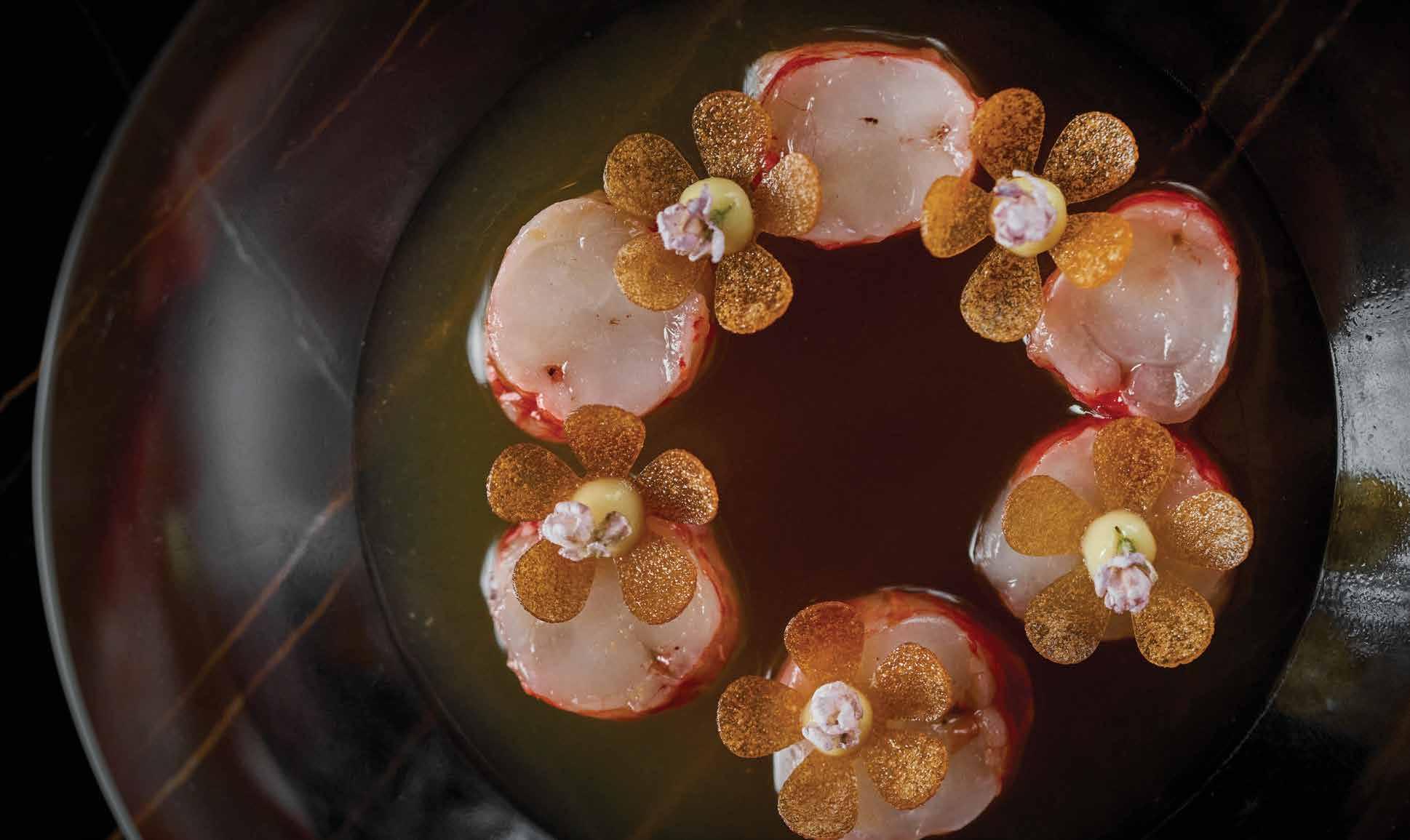
“I said to Ferran: ‘Look, I'll wash the pans and do the prep, and no one has to communicate with me. Just show me what you want and I’ll do it.’”
He did everything faster than the other new recruits to the necessary exacting standards, earning his spot on the team as the first non-Spanish, nonSpanish-speaking chef, and doing the first of three years without pay. “Those years were probably the most important of my career.”
That statement stems partly from El Bulli’s vaunted reputation. “I didn't realise at the time just how important Ferran was going to be globally, because there were some nights when we cooked for an empty restaurant, and we had three Michelin stars! I’d left by the time Ferran was awarded the title of world’s best chef, but that summer they had two million requests for 33,000 seats.”
Returning home to the UK, Atherton gave a number of interviews related to his time at El Bulli which helped shine a light on his own career. Excelling in his first head chef role earned the attention
of Gordon Ramsay, who in 2001 was looking for emerging talents to facilitate the global expansion of his Gordon Ramsay Group. The pair went for coffee one Sunday morning. “Gordon told me about Verre and I flew to Dubai. That changed everything for me.”
Atherton has since made his own global footprint, with restaurants from St. Moritz to Shanghai, and he’s turned Dubai’s Grosvenor House into his own culinary enclave – just below Row on 45 is an outpost of his London favourite City Social, a Japaneseinspired speakeasy called 7 Tales, and the intimate Jazz by City. Despite the success, the inner drive for more is still strong.
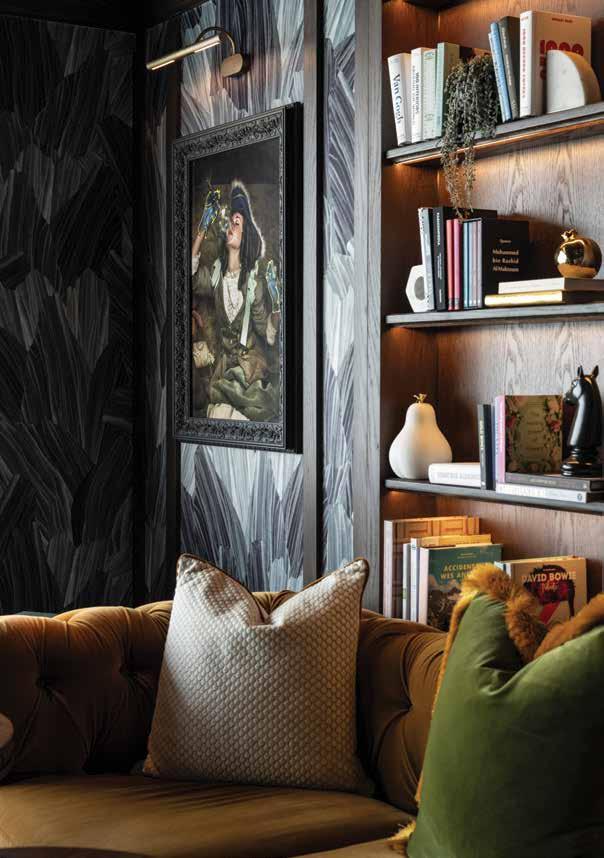
“Being driven is not something you just turn on and off whenever you want. It's just not possible. Successful people can’t do that. I don't say, right, by the time I'm 60 I need to have 50 restaurants and my turnover needs to be $1 billion. That’s not my motivation. My motivation is for us (The Social Company) to be known as a worldleading hospitality group and that wherever we go we do an excellent job and make an impact in that city.”
His impact on Dubai has taken fine dining to a whole new level. Be quick to RSVP to his dinner invitation.
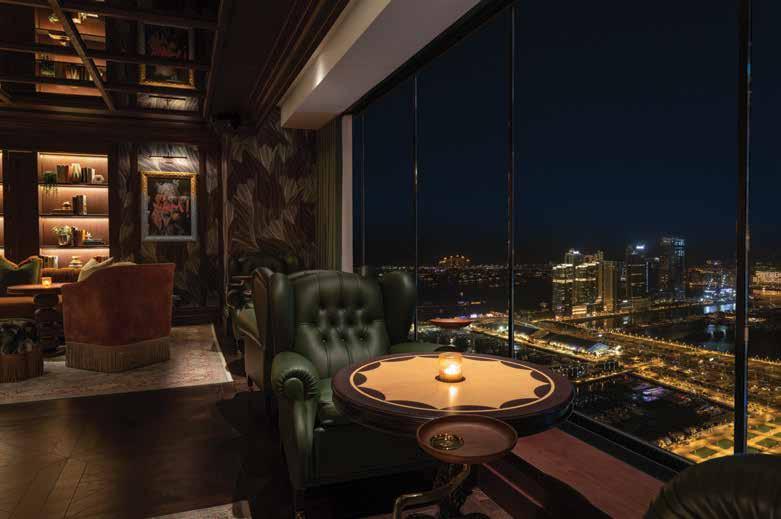
69
Mandarin Oriental Tokyo Japan

70 AIR Travel OCTOBER 2023: ISSUE 145
Check in at Mandarin Oriental Tokyo is an elevated experience. It’s also jaw-dropping.







The formalities are tended to on the top floors of the cloud-skimming Nihonbashi Mitsui Tower, where giant windows grant you a birds-eye view that stretches from the sprawling city to — on a clear day, at least — the majestic Mount Fuji. There’s a real sense that you have arrived at your destination.
Ask for a room on the tower’s west side and Mount Fuji will also be the first thing you see when your curtain parts each morning, in-room binoculars on hand for a sharper view. One such room (in which binoculars are upgraded to a telescope) is the magnificent Presidential Suite, the design of which brings the outside in, via a wholewall image of sunlight piercing through the branches of trees, photographed in a park below. Similarly evocative of Tokyo’s calmer side is the ceiling above your bed, designed to conjure the feeling of staring up at the sky.
Fine vistas from myriad vantage points are a feature right throughout the hotel, but perhaps they’re best at what is a sublime spa. Here you’ll find the unique Bathing Suite, where an indulgently sized infinity bathtub runs the length of a floor-to-ceiling window, looking out to the sprawl of cheek-by-jowl buildings below. You can soak up this cinema-worthy scene for over three hours as
part of a hugely relaxing bathing ritual, a rewarding experience that’s bookended by a full-body exfoliation, massage, and facial, administered using Mandarin Oriental’s own blend of essential oils. Also very much Mandarin Oriental’s own is its atmospheric bar. The guidebooks will all tell you to head across town to the Park Hyatt’s New York Bar, made famous by Lost In Translation Do so and you’ll be disappointed as you stand in line with other first-time visitors, sucked-in to pay an entrance fee for a drink at a bar that feels every bit the tourist trap. Far more authentic (its warm, jovial vibe aided by a great pianist) is Mandarin Bar, tended by some of the best in the business. Creating the right atmosphere is an important element throughout the hotel, which is why its 9-seat-only Pizza Bar on 38th (ranked first in the 50 Top Pizza Asia Pacific 2023 awards) and 8-seatonly (and highly imaginative) Tapas Molecular Bar aren’t tucked away on their own but housed within wider restaurant spaces. They’re all the better for being so. For a high-end take on traditional Cantonese dishes, Sense is must-dine. Like everything else at this cloudskimming hotel — service through to facilities — it’s on another level.
71
Signature
Oriental Suite
Tapas Molecular Bar
Sense
Spa Tranquility Suite
Nadine Kanso
FOUNDER & CREATIVE DESIGNER OF BIL ARABI
The best piece of advice I’ve ever received is to make your decision, own it, and don’t regret it. This advice has been a guiding principle in my life. It emphasises the importance of taking ownership of our choices and being accountable for the outcomes, whether positive or negative. It encourages a proactive approach to decision-making, instilling confidence in one’s ability to navigate life’s challenges.
One thing I do every day is savour a moment of tranquillity with my cats in my garden while enjoying a cup of coffee. This daily ritual provides me with a sense of peace and connection to nature. It’s a simple pleasure that allows me to start each day with a calm and positive mindset.
A lesson I learned the hard way was placing too much trust in people and assuming they would follow through on their promises. It’s a difficult
realisation when you discover that not everyone has the same level of integrity, or commitment to their word. This taught me to be more discerning in my relationships and to place my trust wisely.
Outside of work, I draw inspiration from various sources, including photography, art, and travel. These pursuits allow me to explore different perspectives, cultures, and forms of self-expression. Photography captures moments of beauty and truth, art transcends boundaries, and travel broadens my horizons. They collectively fuel my creativity and enrich my understanding of the world.
My definition of personal success is exceeding one’s own expectations. Success is a deeply personal and evolving concept. It’s not merely about achieving external milestones but continuously pushing the boundaries of what we believe is possible for ourselves. It’s about
growth, self-discovery, and embracing challenges as opportunities for growth.
If I could offer advice to my younger self, it would be to think big and believe in yourself. Sometimes, selfdoubt and fear of failure can hold us back from pursuing ambitious goals. I would encourage my younger self to embrace audacious dreams and have faith in my abilities to overcome obstacles.
My ambitions revolve around growing bigger and stronger while promoting global appreciation for our Arab identity. It’s important to me that our rich culture, heritage, and contributions are recognised and celebrated worldwide. I aspire to be a part of this cultural resurgence, and play a role in shaping a more inclusive and diverse global landscape. That is what Bil Arabi jewellery is all about.

What I Know Now 72 OCT 2023 : ISSUE 145 AIR
Illustration: Leona Beth

LUXURY RESIDENTIAL REAL ESTATE prime.bhomes.com
A Racing Machine On The Wrist



























































































































































































































 WORDS: CHRIS ANDERSON
WORDS: CHRIS ANDERSON























